
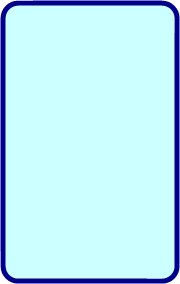
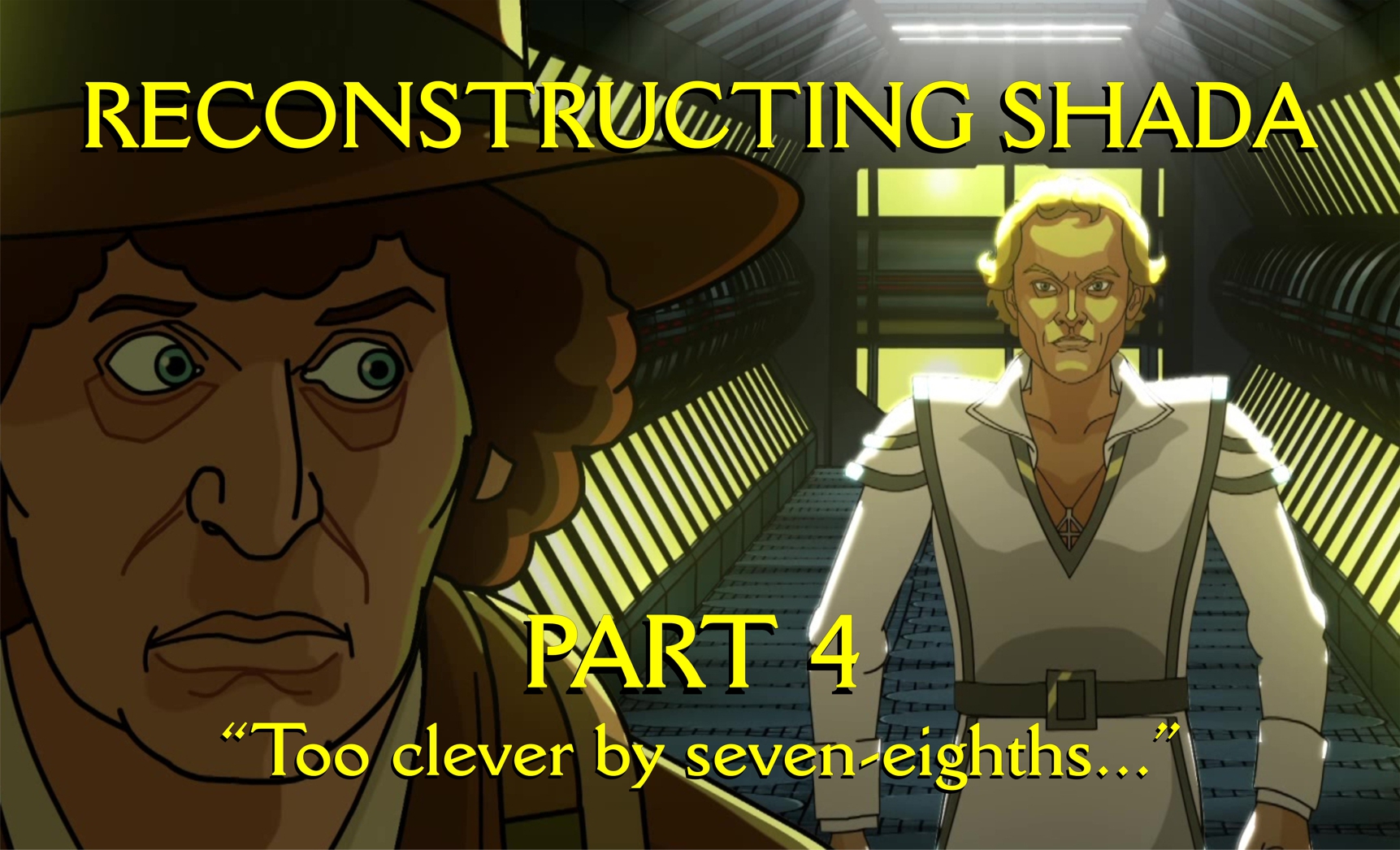
• CHARLES NORTON:
The logic behind us putting the Doctor on the floor here was two-fold. Firstly, it was an interesting composition that helped break up what would otherwise have been a fairly static scene. Secondly, it helped us pre-figure a similar bit of staging that I already had in mind for the final scene of the story.
Incidentally, if you look very carefully, you can see a little black mark at the bottom of the frame in this shot. In case you were wondering, it's a pencil smudge. You get a really close look at Graham's lovely brush-work here too.
The logic behind us putting the Doctor on the floor here was two-fold. Firstly, it was an interesting composition that helped break up what would otherwise have been a fairly static scene. Secondly, it helped us pre-figure a similar bit of staging that I already had in mind for the final scene of the story.
Incidentally, if you look very carefully, you can see a little black mark at the bottom of the frame in this shot. In case you were wondering, it's a pencil smudge. You get a really close look at Graham's lovely brush-work here too.

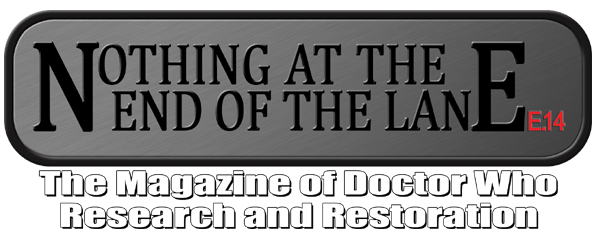
All timings in this article are taken from the 2017 master file for Shada. Whether you are watching the original 2017 DVD/BluRay; the 2021 Season 17 Blu-ray Collection box-set re-issue or the German-dubbed Polyband DVD/BluRay, the timings should still all match those cited here. It doesn't matter which edition you watch, as they should all use the same edit of the production. Of course, if you're watching the alternate 6-part special feature on the 2021 box-set or if you're watching the 1992 VHS compilation, then the timings won't match. So, if you are reading these viewing notes as you watch, make sure you're playing the right disc.
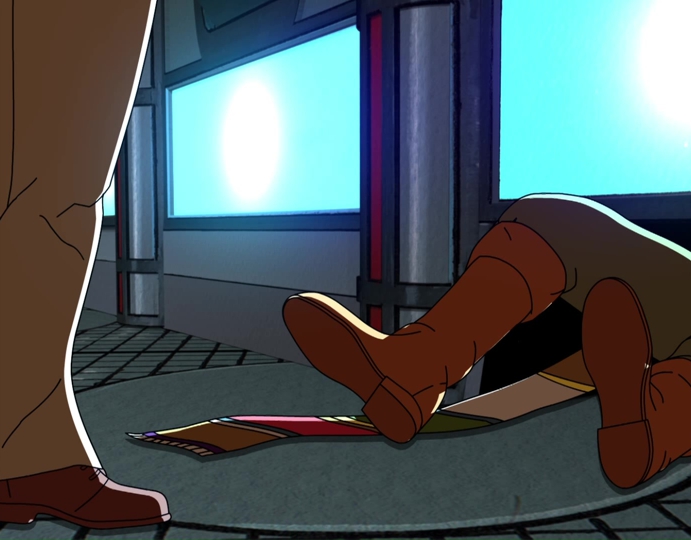
1:15:50 - The Doctor works on the ship
1:17:00 - Skagra's ship leaves the field
• CHARLES NORTON:
This shot was actually completed by the original production team back in 1979. However, in spite of this it still ended up being largely reshot by us in 2017.
In 1979, they filmed the background of the field on location, with the camera pitching up to the sky. Then, a few days later, they shot a miniature of the ship itself on VT, during an extremely hurried VFX studio shoot at Television Centre. The two bits of footage were put together live, by a vision mixer during the studio shoot - with the vision mixer trying to match the output of the camera to the previously shot film, all done by eye. If you watch the raw studio tapes, you can see (and hear) that all of this was done is something of a desperate rush. And none of it really worked very well. We have the finished footage from that day and there's a couple of takes of the ship taking off. However, both takes look quite poor. We know that Pennant Roberts had planned to spend some more time on the VFX model work in a later studio session, to redo what they'd not been able to satisfactorily complete before. I think it's quite possible that this is one of the shots that they would have chosen to re-visit.
Mike Tucker had already built a full practical miniature of the spaceship for use in a number of other scenes. As we had that miniature to hand and as we had a sound stage for two days, we decided to completely redo the shot of Skagra's ship taking off from the field. Even though, it did admittedly mean us scrapping some initially completed footage and doing it all again.
• MIKE TUCKER:
Skagra’s spacecraft miniature was flown upside down for the flying shots, before being rigged against a blue screen for shots requiring the model to be composited with the live action footage.
• CHARLES NORTON:
We set up a large blue-screen and suspended the ship miniature from a jib on thin wires. It was then moved around on that jib to get whatever motion we needed, before being swung out of shot behind the camera crew. It was lit sympathetically to give a sense that it was out in the open air in broad daylight. The next shot of it in space was done in a similar way, but lit differently and with a starry backing cloth instead of a blue-screen. All shot on 16mm film on the Arri.
This shot was actually completed by the original production team back in 1979. However, in spite of this it still ended up being largely reshot by us in 2017.
In 1979, they filmed the background of the field on location, with the camera pitching up to the sky. Then, a few days later, they shot a miniature of the ship itself on VT, during an extremely hurried VFX studio shoot at Television Centre. The two bits of footage were put together live, by a vision mixer during the studio shoot - with the vision mixer trying to match the output of the camera to the previously shot film, all done by eye. If you watch the raw studio tapes, you can see (and hear) that all of this was done is something of a desperate rush. And none of it really worked very well. We have the finished footage from that day and there's a couple of takes of the ship taking off. However, both takes look quite poor. We know that Pennant Roberts had planned to spend some more time on the VFX model work in a later studio session, to redo what they'd not been able to satisfactorily complete before. I think it's quite possible that this is one of the shots that they would have chosen to re-visit.
Mike Tucker had already built a full practical miniature of the spaceship for use in a number of other scenes. As we had that miniature to hand and as we had a sound stage for two days, we decided to completely redo the shot of Skagra's ship taking off from the field. Even though, it did admittedly mean us scrapping some initially completed footage and doing it all again.
• MIKE TUCKER:
Skagra’s spacecraft miniature was flown upside down for the flying shots, before being rigged against a blue screen for shots requiring the model to be composited with the live action footage.
• CHARLES NORTON:
We set up a large blue-screen and suspended the ship miniature from a jib on thin wires. It was then moved around on that jib to get whatever motion we needed, before being swung out of shot behind the camera crew. It was lit sympathetically to give a sense that it was out in the open air in broad daylight. The next shot of it in space was done in a similar way, but lit differently and with a starry backing cloth instead of a blue-screen. All shot on 16mm film on the Arri.
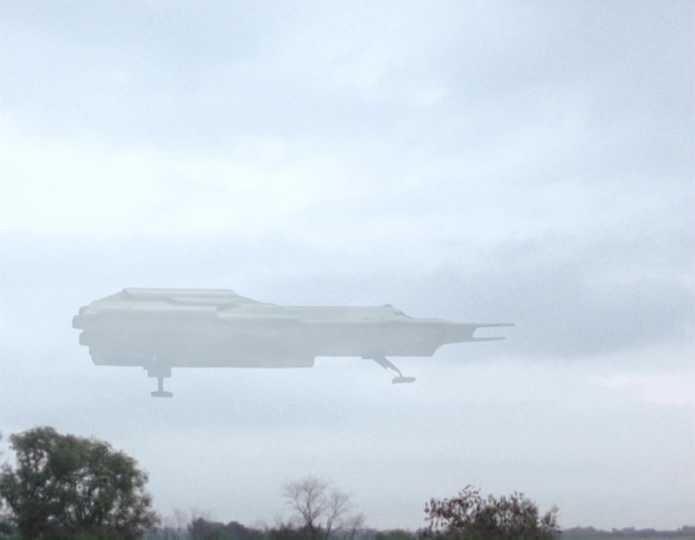
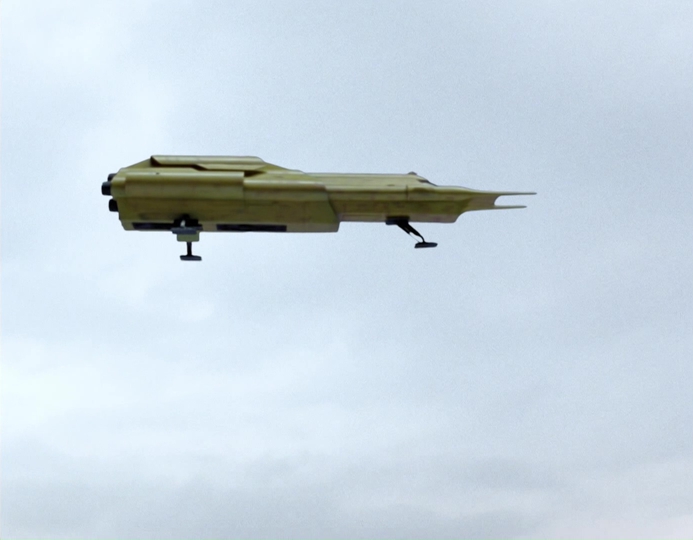
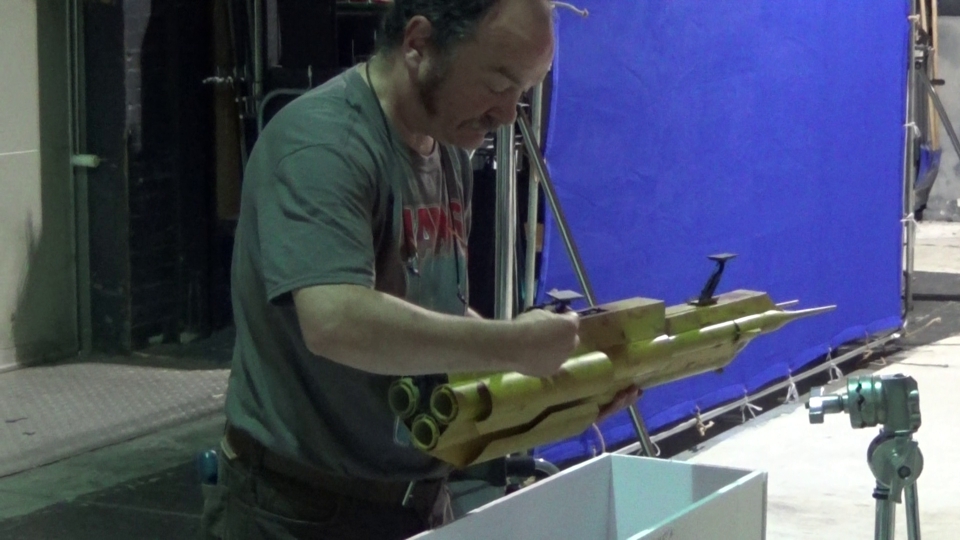
Mike Tucker working on Skagra's ship at Halliford Studios
on 9th August, 2017(Image © Charles Norton)
on 9th August, 2017(Image © Charles Norton)
1:17:40 - Chris picks himself up off the floor
• CHARLES NORTON:
Looking through my notes, I see that we recorded Daniel Hill's line of "what are you doing..." twice. We recorded it first on 9th June 2017 and then re-recorded it on 26th June 2017. Listening back through the two takes, I now no longer have any idea why we did that.
As scripted, the ship stopping was originally planned to be conveyed via another model shot. However, I thought we could probably do it more effectively by just having Chris crash to the floor, with the Doctor, of course, remaining standing throughout.
Looking through my notes, I see that we recorded Daniel Hill's line of "what are you doing..." twice. We recorded it first on 9th June 2017 and then re-recorded it on 26th June 2017. Listening back through the two takes, I now no longer have any idea why we did that.
As scripted, the ship stopping was originally planned to be conveyed via another model shot. However, I thought we could probably do it more effectively by just having Chris crash to the floor, with the Doctor, of course, remaining standing throughout.
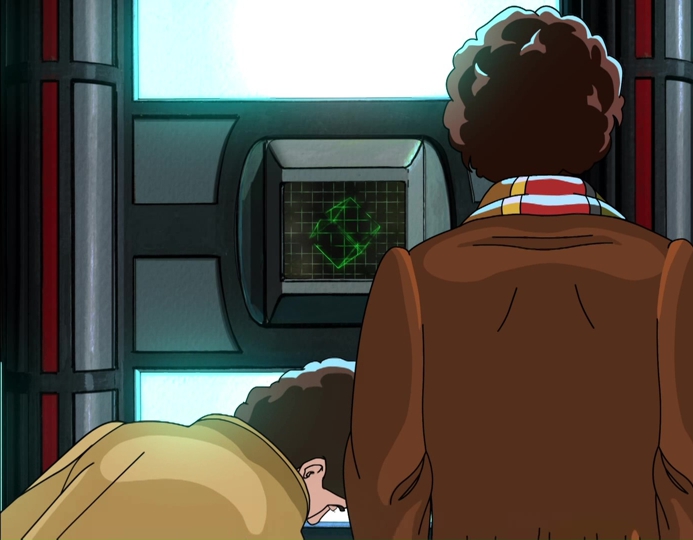
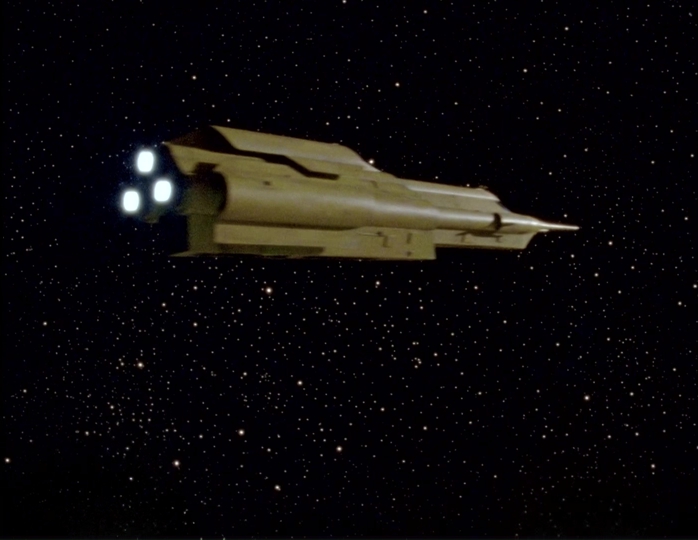
1:18:25 - The Krarg awakes
• CHARLES NORTON:
There was originally scripted to be a little bit of extra dialogue here from the Doctor. It would have played over the top of the action, as if his voice is being relayed from another room. It would have just been some more technobabble relating to his re-programming of the ship: "Switch your conceptual geometer from analogue to digital mode and keep triggering feedback responses till you get a reading of 75 dash 839."
We recorded this speech with Tom at Audio Sorcery Studios on 9th June 2017. However, watching the scene back now, I notice that we don't appear to have used any of Tom's audio in the finished scene. I don't remember why we made this decision now. However, I can only assume that I just felt the scene was more effective without the voice-over. The visual of the Krarg clawing its way out of the vat sort of works on its own and Mark Ayres' ominous music is doing all the rest of the heavy thematic lifting. Anything from Tom would probably just have been lost in the mix.
• MARK AYRES:
I also think it was dropped because it didn’t work. Charles suggested I look at it again when I did the six-part edit, but I couldn’t get it to work then, either. Better out than in, as they say.
There was originally scripted to be a little bit of extra dialogue here from the Doctor. It would have played over the top of the action, as if his voice is being relayed from another room. It would have just been some more technobabble relating to his re-programming of the ship: "Switch your conceptual geometer from analogue to digital mode and keep triggering feedback responses till you get a reading of 75 dash 839."
We recorded this speech with Tom at Audio Sorcery Studios on 9th June 2017. However, watching the scene back now, I notice that we don't appear to have used any of Tom's audio in the finished scene. I don't remember why we made this decision now. However, I can only assume that I just felt the scene was more effective without the voice-over. The visual of the Krarg clawing its way out of the vat sort of works on its own and Mark Ayres' ominous music is doing all the rest of the heavy thematic lifting. Anything from Tom would probably just have been lost in the mix.
• MARK AYRES:
I also think it was dropped because it didn’t work. Charles suggested I look at it again when I did the six-part edit, but I couldn’t get it to work then, either. Better out than in, as they say.
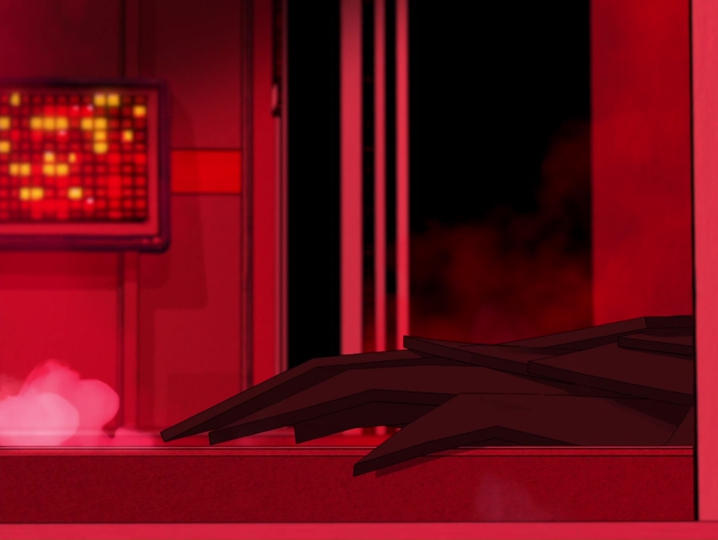
1:18:48 - The ship vanishes
• CHARLES NORTON:
A very small re-ordering of scenes here. In the original rehearsal script, you got the ship dematerialising followed by the scene of the Doctor talking about the dimensional stabiliser. I swapped them round. So, in the final edit, you get the scene with the Doctor first and then the model shot of the ship dematerialising. In doing so, I consolidate all the live action (after the scene on the ship), rather than cutting back and forth between two brief scenes of live action and animation.
A very small re-ordering of scenes here. In the original rehearsal script, you got the ship dematerialising followed by the scene of the Doctor talking about the dimensional stabiliser. I swapped them round. So, in the final edit, you get the scene with the Doctor first and then the model shot of the ship dematerialising. In doing so, I consolidate all the live action (after the scene on the ship), rather than cutting back and forth between two brief scenes of live action and animation.
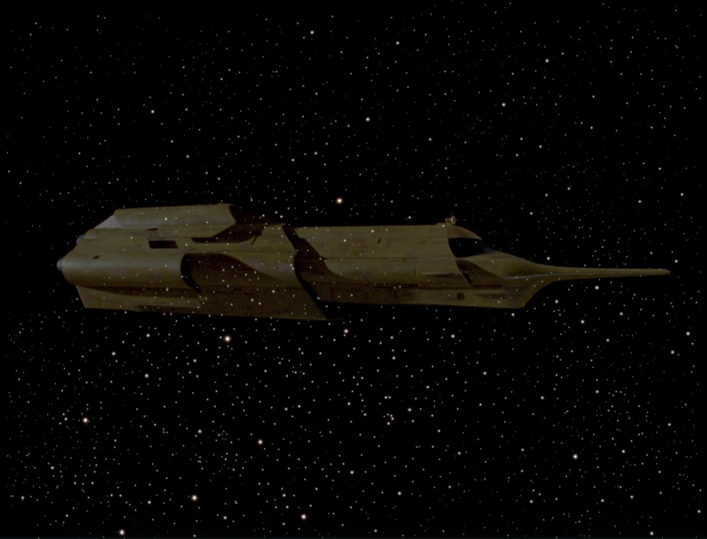
1:18:55 - Skagra doesn't review the Doctor's mind
• CHARLES NORTON:
As originally scripted, there was a short scene between Romana and Skagra here. We did actually record the audio for this with Lalla Ward and Christopher Neame at Motivation Sound on 26th June 2017. However, we never actually created any animation to accompany it. Even at the time of recording the audio, I'd already made a note on my script, that if we were over-running and needed to make any cuts, then this scene would be an obvious one we could lose. And so it transpired. The scene has a nice line about the Doctor being fond of Romana, but in all other respects, everything in this scene is repeated in a later scene a few minutes later. To avoid the repetition, keep the story moving and to get the duration down, I'm afraid it was cut. It's one of our very few actual deleted scenes - in that it was recorded and then cut from the edit. As opposed to us deciding never to record something at all.
• MARK AYRES:
We’ve completed this scene and included it in the 2021 six-part version, as per the images left. Charles pointed me to the dialogue file and some suitable animation elements and I comp’d it to match the later similar scene.
As originally scripted, there was a short scene between Romana and Skagra here. We did actually record the audio for this with Lalla Ward and Christopher Neame at Motivation Sound on 26th June 2017. However, we never actually created any animation to accompany it. Even at the time of recording the audio, I'd already made a note on my script, that if we were over-running and needed to make any cuts, then this scene would be an obvious one we could lose. And so it transpired. The scene has a nice line about the Doctor being fond of Romana, but in all other respects, everything in this scene is repeated in a later scene a few minutes later. To avoid the repetition, keep the story moving and to get the duration down, I'm afraid it was cut. It's one of our very few actual deleted scenes - in that it was recorded and then cut from the edit. As opposed to us deciding never to record something at all.
• MARK AYRES:
We’ve completed this scene and included it in the 2021 six-part version, as per the images left. Charles pointed me to the dialogue file and some suitable animation elements and I comp’d it to match the later similar scene.
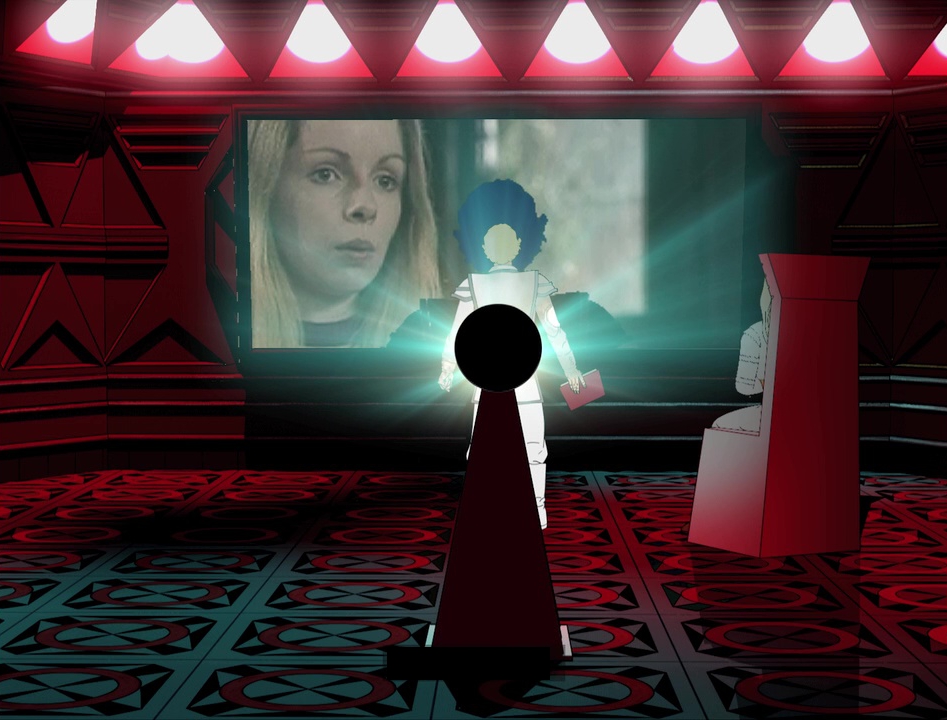
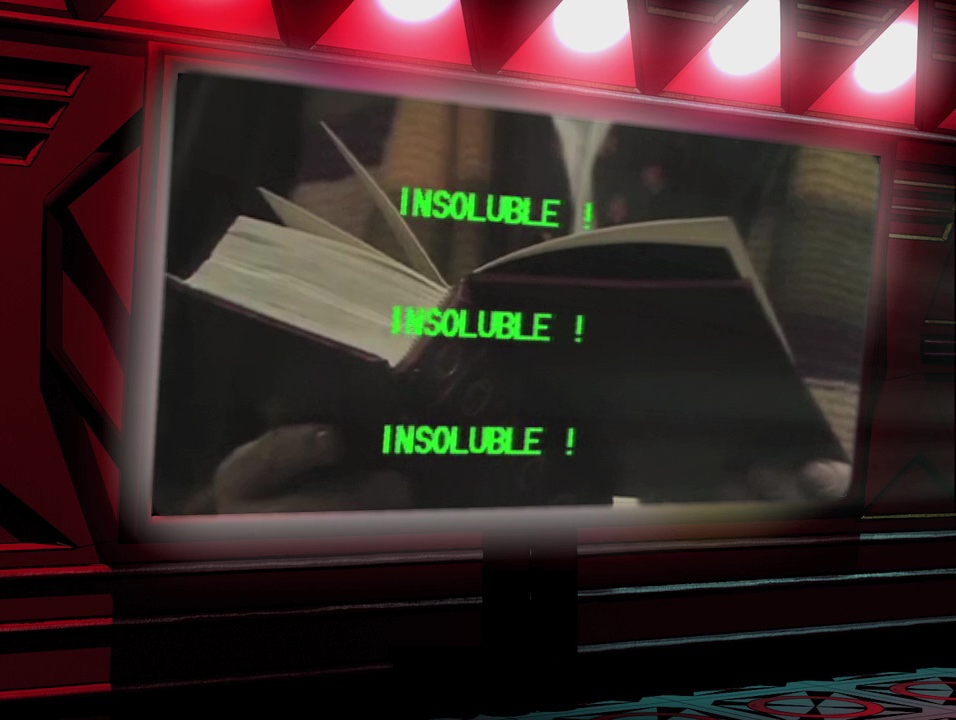
1:20:10 - The dead Chronotis makes tea
• CHARLES NORTON:
This scene was subject to some restructuring in the edit. It was originally scripted to play as two shorter scenes, spaced several minutes apart. We took these two shorter scenes and joined them together in the edit. The join between the two scenes comes at roughly 1:20:10.
Originally, Chronotis left the room to make the tea and then the first scene ended. There would then have been a huge amount of material (around half a dozen scenes involving Chris, the Doctor, Romana and Skagra) before we finally returned to Chronotis with the tea tray. The narrative effect of this on the viewer would have been that it took Chronotis at least a quarter of an hour to make the tea, which is a long time, even for a corpse. Leaving the scene order as it was would also have increased the inter-cutting between live-action and animation. So, we decided to merge the two scenes together.
I can see why they split the two scenes to begin with. It does sort of work in the context of the conversation between Clare and Chronotis. However, by having such a massive gap between the two halves of the action, it still feels quite odd. As scripted, the second Clare and Chronotis scene would have cut right into the middle of a section with the Doctor, Chris and the Krarg. This would have robbed that material of its urgency and sense of danger. It's a structural problem in the material to which there is no perfect solution, to be honest. At least, no editing solution. However, I think that the merging of the two scenes is relatively acceptable and it helps the pacing of the later material with the Krarg enormously, as we now no longer cut away from the action at such a vital point.
Most of Pennant Roberts' camera script for this part of Shada is incomplete. He simply never got round to plotting out most of the scenes (Chronotis and Clare material aside). As such we've no idea what editing solutions he may have found had he completed this all as planned back in 1979. He may have even ended up editing exactly as we did.
• MARK AYRES:
This is back as two scenes in 2021's six-part version, split only by the short new scene (as above) with Skagra and Romana. So it only takes Chronotis a couple of minutes to make the tea.
This scene was subject to some restructuring in the edit. It was originally scripted to play as two shorter scenes, spaced several minutes apart. We took these two shorter scenes and joined them together in the edit. The join between the two scenes comes at roughly 1:20:10.
Originally, Chronotis left the room to make the tea and then the first scene ended. There would then have been a huge amount of material (around half a dozen scenes involving Chris, the Doctor, Romana and Skagra) before we finally returned to Chronotis with the tea tray. The narrative effect of this on the viewer would have been that it took Chronotis at least a quarter of an hour to make the tea, which is a long time, even for a corpse. Leaving the scene order as it was would also have increased the inter-cutting between live-action and animation. So, we decided to merge the two scenes together.
I can see why they split the two scenes to begin with. It does sort of work in the context of the conversation between Clare and Chronotis. However, by having such a massive gap between the two halves of the action, it still feels quite odd. As scripted, the second Clare and Chronotis scene would have cut right into the middle of a section with the Doctor, Chris and the Krarg. This would have robbed that material of its urgency and sense of danger. It's a structural problem in the material to which there is no perfect solution, to be honest. At least, no editing solution. However, I think that the merging of the two scenes is relatively acceptable and it helps the pacing of the later material with the Krarg enormously, as we now no longer cut away from the action at such a vital point.
Most of Pennant Roberts' camera script for this part of Shada is incomplete. He simply never got round to plotting out most of the scenes (Chronotis and Clare material aside). As such we've no idea what editing solutions he may have found had he completed this all as planned back in 1979. He may have even ended up editing exactly as we did.
• MARK AYRES:
This is back as two scenes in 2021's six-part version, split only by the short new scene (as above) with Skagra and Romana. So it only takes Chronotis a couple of minutes to make the tea.
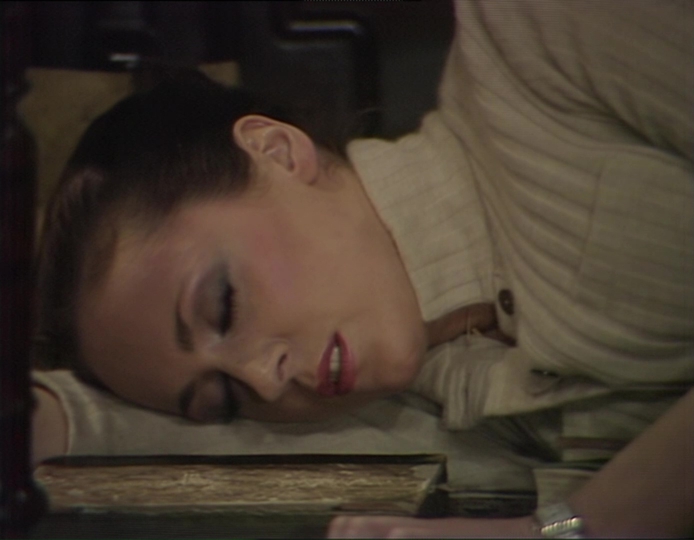
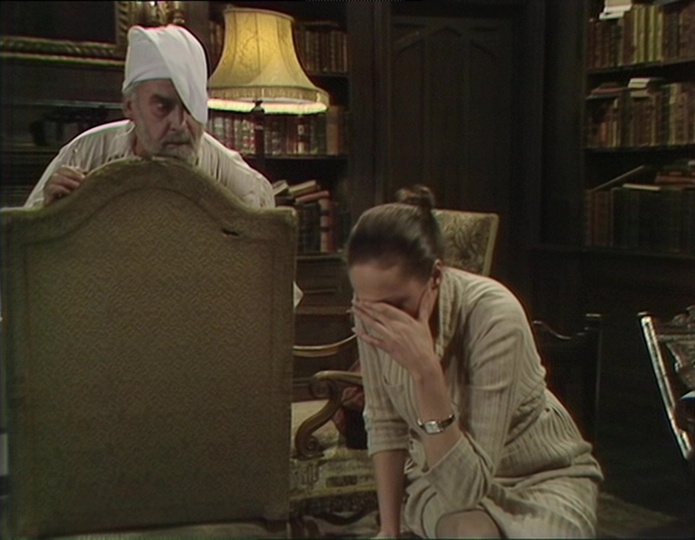
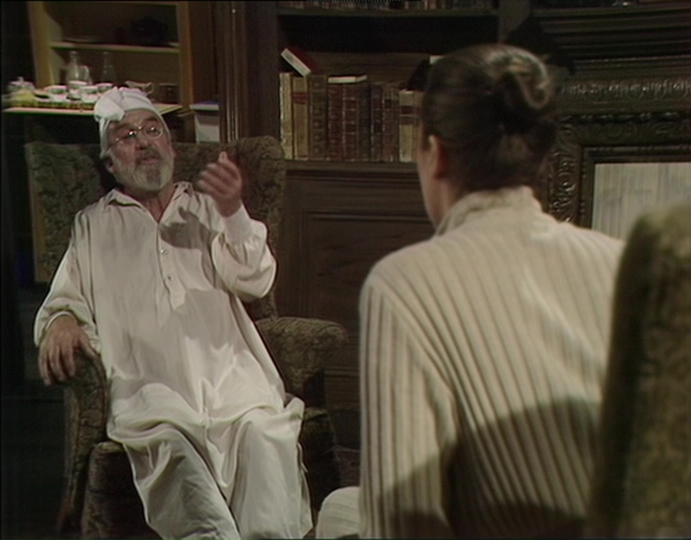
1:22:12 - The Doctor and Chris don't talk about Skagra
• CHARLES NORTON:
As originally scripted, we should have cut to some material aboard Skagra's spaceship here. There was a scene in which Chris and the Doctor wonder about who Skagra is. They don't come to any conclusion on the matter and the scene ends with a line from the Doctor that is extremely similar to Chronotis' closing line from the previous scene with Clare.
For reasons of both pacing and the avoidance of repetition, we decided not to record the scene with the Doctor and Chris. In fact, the scene screams so loudly of 'padding' that I suspect it wouldn't have made it to Pennant Roberts' final edit in 1979 either. It's not anywhere to be found in his camera scripts for the six-part version of the story he was working on in 1979. However (somewhat surprisingly), it is included in the scripts for the much shorter four part version that was in preparation in 1980, together with camera directions from Roberts.
As originally scripted, we should have cut to some material aboard Skagra's spaceship here. There was a scene in which Chris and the Doctor wonder about who Skagra is. They don't come to any conclusion on the matter and the scene ends with a line from the Doctor that is extremely similar to Chronotis' closing line from the previous scene with Clare.
For reasons of both pacing and the avoidance of repetition, we decided not to record the scene with the Doctor and Chris. In fact, the scene screams so loudly of 'padding' that I suspect it wouldn't have made it to Pennant Roberts' final edit in 1979 either. It's not anywhere to be found in his camera scripts for the six-part version of the story he was working on in 1979. However (somewhat surprisingly), it is included in the scripts for the much shorter four part version that was in preparation in 1980, together with camera directions from Roberts.
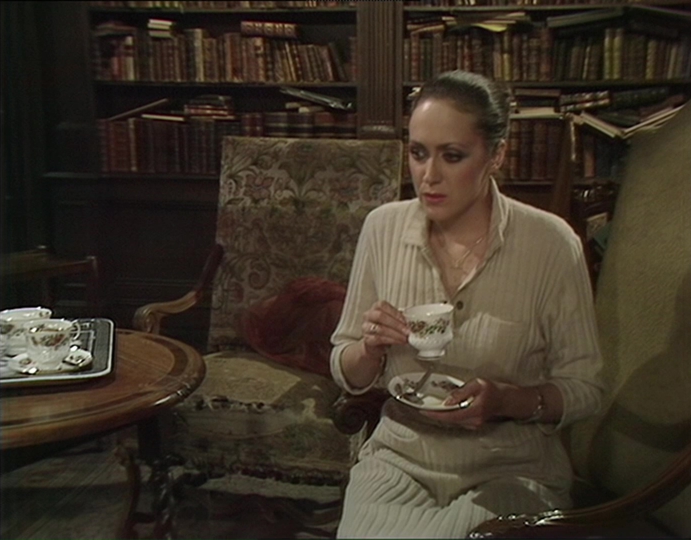
1:22:12 - Clare and Romana sit on chairs
• CHARLES NORTON:
A match-cut there, as we move out of one scene and into the next. Clare sitting in the chair at the end of the scene in Chronotis' room matching up to Romana sitting in the chair on the ship. Another way of trying to better manage the transitions between live-action and animation.
A match-cut there, as we move out of one scene and into the next. Clare sitting in the chair at the end of the scene in Chronotis' room matching up to Romana sitting in the chair on the ship. Another way of trying to better manage the transitions between live-action and animation.
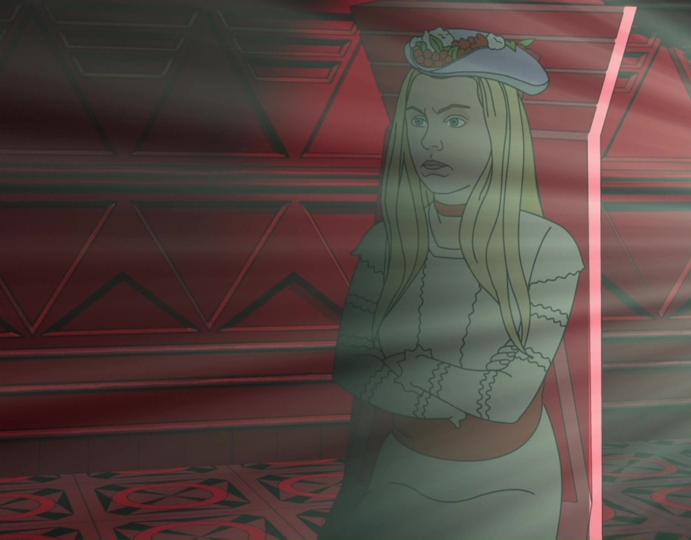
1:23:48 - The Doctor and Chris wait for the ship to dock
• CHARLES NORTON:
The first seven seconds of this scene were removed for the BBC America transmission. Just the close-up shot of Tom.
Curiously, I see from my notes that there was supposed to be a transition between the end of the last scene and the start of this one. I've written down that I wanted a slow cross-dissolve between Romana's face and the Doctor's face. And yet there's no dissolve in the final edit - just a hard cut. I can't remember why we didn't do the dissolve now. We should have done. It would have been better.
The first seven seconds of this scene were removed for the BBC America transmission. Just the close-up shot of Tom.
Curiously, I see from my notes that there was supposed to be a transition between the end of the last scene and the start of this one. I've written down that I wanted a slow cross-dissolve between Romana's face and the Doctor's face. And yet there's no dissolve in the final edit - just a hard cut. I can't remember why we didn't do the dissolve now. We should have done. It would have been better.
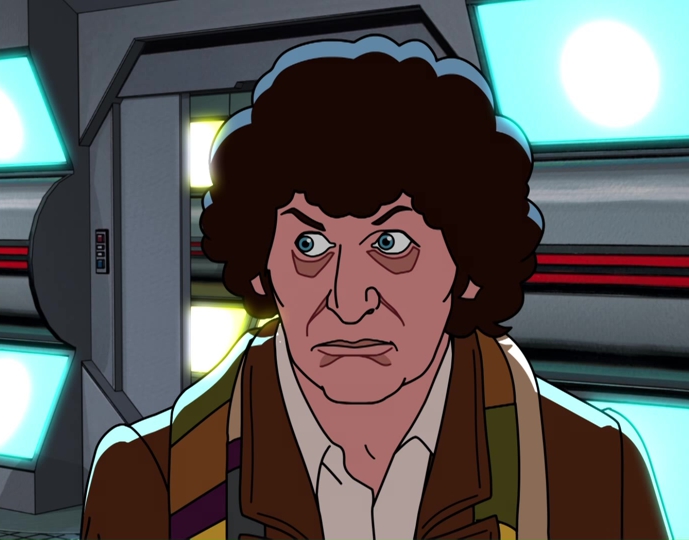
1:24:05 - The Krarg confronts the Doctor and Chris
• CHARLES NORTON:
The Krargs were all animated by Rob Ritchie. To give him as much reference for the movement as possible, we brought in performer Barnaby Edwards to act out each and every shot featuring the Krarg during a live-action reference shoot that took place at Camberwell Studios in London on 7th June 2017. This footage was then used by Rob to map out the CGI Krarg's animated performance.
It's not quite motion capture and its not quite rotoscoping. However, it's in that area. Using live action performance to better hone an animated character's performance. We didn't just do it with the Krargs either. A number of scenes featuring Chris, Skagra and the Doctor were mapped out in this way too. Although, in those cases, it was in order to provide reference material for the 2D animators to work from.
The live action reference material for Chris (largely of scenes in the lab) was all acted out by Daniel Hill himself. However, it wasn't practical to get Tom Baker and Chris Neame down on the day to perform their characters, so I brought in actor Tim Bentinck to help us out. He has a very similar build to Tom, which would be useful for us in other ways too. Of which more later.
I'd worked with both Barnaby and Tim before on a radio drama I produced back in 2013 and I knew they'd be great to work with again. Tim, of course, also appeared as the voice of the monk in The Pyramid at the End of the World and Extremis for Peter Capaldi's final season of Doctor Who. In fact, he completed his work on that just a few weeks before joining us on Shada.
The Krargs were all animated by Rob Ritchie. To give him as much reference for the movement as possible, we brought in performer Barnaby Edwards to act out each and every shot featuring the Krarg during a live-action reference shoot that took place at Camberwell Studios in London on 7th June 2017. This footage was then used by Rob to map out the CGI Krarg's animated performance.
It's not quite motion capture and its not quite rotoscoping. However, it's in that area. Using live action performance to better hone an animated character's performance. We didn't just do it with the Krargs either. A number of scenes featuring Chris, Skagra and the Doctor were mapped out in this way too. Although, in those cases, it was in order to provide reference material for the 2D animators to work from.
The live action reference material for Chris (largely of scenes in the lab) was all acted out by Daniel Hill himself. However, it wasn't practical to get Tom Baker and Chris Neame down on the day to perform their characters, so I brought in actor Tim Bentinck to help us out. He has a very similar build to Tom, which would be useful for us in other ways too. Of which more later.
I'd worked with both Barnaby and Tim before on a radio drama I produced back in 2013 and I knew they'd be great to work with again. Tim, of course, also appeared as the voice of the monk in The Pyramid at the End of the World and Extremis for Peter Capaldi's final season of Doctor Who. In fact, he completed his work on that just a few weeks before joining us on Shada.
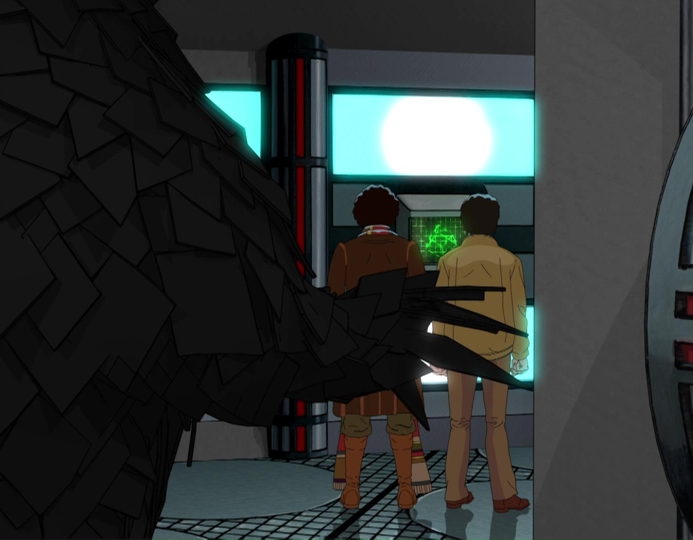
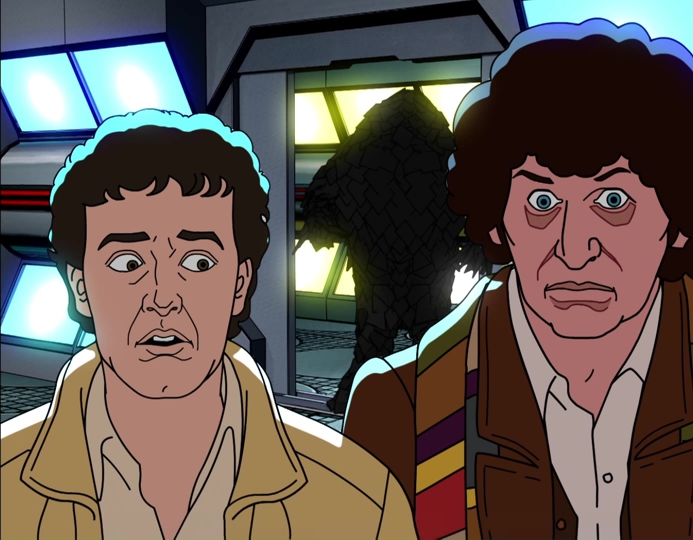
1:24:30 - The Krarg confronts the Doctor and Chris
• CHARLES NORTON:
Again the dialogue has been slightly reworked here. The original scripted version of this scene had more dialogue from K9 that would (in 1979) have been recorded by David Brierley.
In the final 2017 version, we cut K9's lines and also slightly truncated some of the other dialogue in the scene too. Probably the most substantial cut is the loss of K9's line: "Master, I can only just hold him with blaster at maximum power." I also changed the Doctor's scripted line, to tie-in better with the 'Bristol' business that Tom had worked out during the original live-action shoot.
Again the dialogue has been slightly reworked here. The original scripted version of this scene had more dialogue from K9 that would (in 1979) have been recorded by David Brierley.
In the final 2017 version, we cut K9's lines and also slightly truncated some of the other dialogue in the scene too. Probably the most substantial cut is the loss of K9's line: "Master, I can only just hold him with blaster at maximum power." I also changed the Doctor's scripted line, to tie-in better with the 'Bristol' business that Tom had worked out during the original live-action shoot.
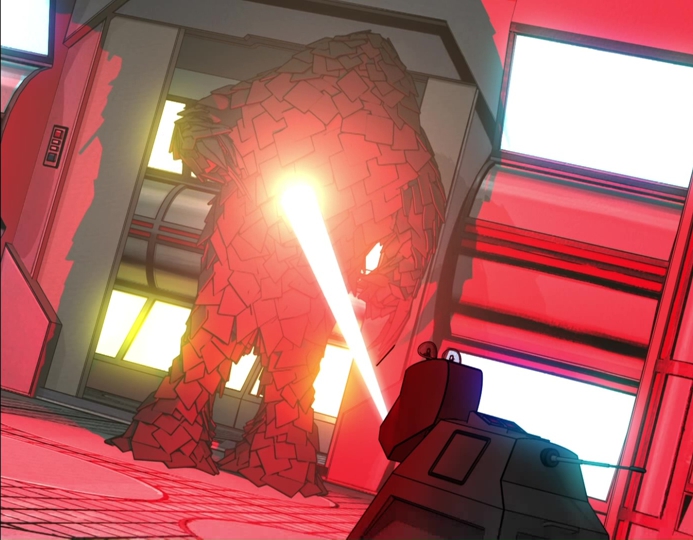
1:24:45 - The ship prepares to dock
• CHARLES NORTON:
At 1:24:45. BBC America went to their next ad break.
At 1:24:45. BBC America went to their next ad break.
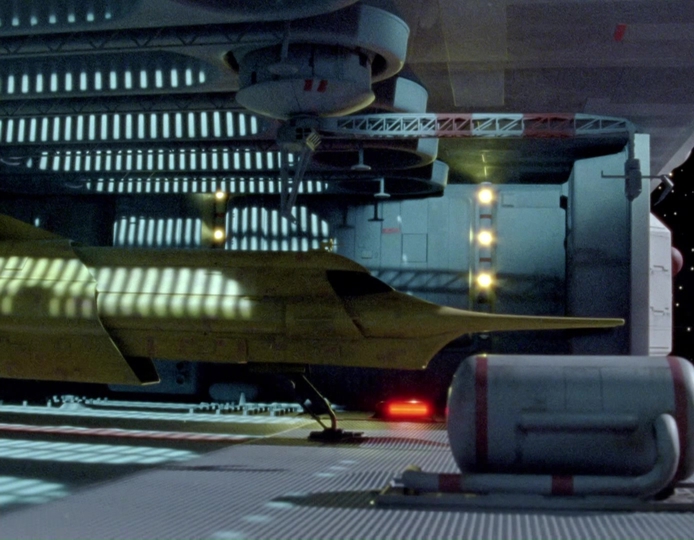
1:25:00 - Skagra and Romana don't talk on the Krarg ship
• CHARLES NORTON:
The rehearsal script had a short scene at this point of Romana and Skagra on the Krarg ship. In it, Skagra is still "snooping through the Doctor's mind," much as he was in his previous scene. The scene merely repeats what has already been established - Skagra is examining the Doctor's thoughts to find out about Shada. It's a very short scene too - only two lines are spoken in the entire thing. It was an obvious trim to make, as we were now over-running far beyond what was initially projected.
The rehearsal script had a short scene at this point of Romana and Skagra on the Krarg ship. In it, Skagra is still "snooping through the Doctor's mind," much as he was in his previous scene. The scene merely repeats what has already been established - Skagra is examining the Doctor's thoughts to find out about Shada. It's a very short scene too - only two lines are spoken in the entire thing. It was an obvious trim to make, as we were now over-running far beyond what was initially projected.
1:25:00 - The ship arrives
• CHARLES NORTON:
Another new shot that we added in, that was never originally planned in 1979, but we thought would be visually interesting. Mike's team did a lovely job on the hangar set. It's the same as the one we saw when Skagra left at the start of the story. It was quite large - maybe five feet across. And you see that flashing red light at the back? That's the light off the back of a bicycle. I think Mike bought it in specially from Halfords.
Another new shot that we added in, that was never originally planned in 1979, but we thought would be visually interesting. Mike's team did a lovely job on the hangar set. It's the same as the one we saw when Skagra left at the start of the story. It was quite large - maybe five feet across. And you see that flashing red light at the back? That's the light off the back of a bicycle. I think Mike bought it in specially from Halfords.
1:25:00 - Chronotis and Clare don't talk
• CHARLES NORTON:
This is where that earlier re-edited Clare and Chronotis scene would have sat in the edit, if we'd kept everything in the order that appears in the rehearsal script.
This is where that earlier re-edited Clare and Chronotis scene would have sat in the edit, if we'd kept everything in the order that appears in the rehearsal script.
1:25:00 - The Doctor and Chris don't make ready to leave
• CHARLES NORTON:
Another slight trim. After the ship arrives on the Think Tank, there was originally another scripted cutaway back to the Doctor and Chris on Skagra's ship. A short scene, little more than the Doctor saying: "Right. Let's go and see where we are..." before haring off out the room. The scene only slows things down. Much better to keep the momentum going and cut straight to the ship (which is what we do in the final edit). I suspect this scene was only there to remind viewers of where Doctor and Chris were, as (according to the scripted scene-order), there would originally have been quite a long gap between the last scene on Skagra's ship and this one here. Our earlier scene juggling with Clare and Chronotis means the gap is now closed up and so this short scene is no longer needed. Funnily enough, we did actually record the audio for this scene. Not because we intended to use it. Simply because I thought it might bump up what was going to otherwise be a very short deleted scenes compilation on the DVD release.
Another slight trim. After the ship arrives on the Think Tank, there was originally another scripted cutaway back to the Doctor and Chris on Skagra's ship. A short scene, little more than the Doctor saying: "Right. Let's go and see where we are..." before haring off out the room. The scene only slows things down. Much better to keep the momentum going and cut straight to the ship (which is what we do in the final edit). I suspect this scene was only there to remind viewers of where Doctor and Chris were, as (according to the scripted scene-order), there would originally have been quite a long gap between the last scene on Skagra's ship and this one here. Our earlier scene juggling with Clare and Chronotis means the gap is now closed up and so this short scene is no longer needed. Funnily enough, we did actually record the audio for this scene. Not because we intended to use it. Simply because I thought it might bump up what was going to otherwise be a very short deleted scenes compilation on the DVD release.
1:25:14 - The Doctor and Chris arrive at the Think Tank
• CHARLES NORTON:
Chris and Tom recorded their lines for the first part of this scene on 9th June 2017 at Audio Sorcery Studios. However, the second part of the conversation was recorded on 5th November 1979 in studio TC3 at BBC Television Centre. The join between the two halves of the conversation happens as Chris appears around the door. Everything up until (and including) Tom's line of "I wonder where everybody's got to?" was recorded in 2017. However, Daniel's reply of "I don't know..." (and everything after that) was recorded in 1979. To cover the rather long period of time before Chris and the Doctor appear, I slightly expanded the dialogue for the first part of the conversation.
Chris and Tom recorded their lines for the first part of this scene on 9th June 2017 at Audio Sorcery Studios. However, the second part of the conversation was recorded on 5th November 1979 in studio TC3 at BBC Television Centre. The join between the two halves of the conversation happens as Chris appears around the door. Everything up until (and including) Tom's line of "I wonder where everybody's got to?" was recorded in 2017. However, Daniel's reply of "I don't know..." (and everything after that) was recorded in 1979. To cover the rather long period of time before Chris and the Doctor appear, I slightly expanded the dialogue for the first part of the conversation.
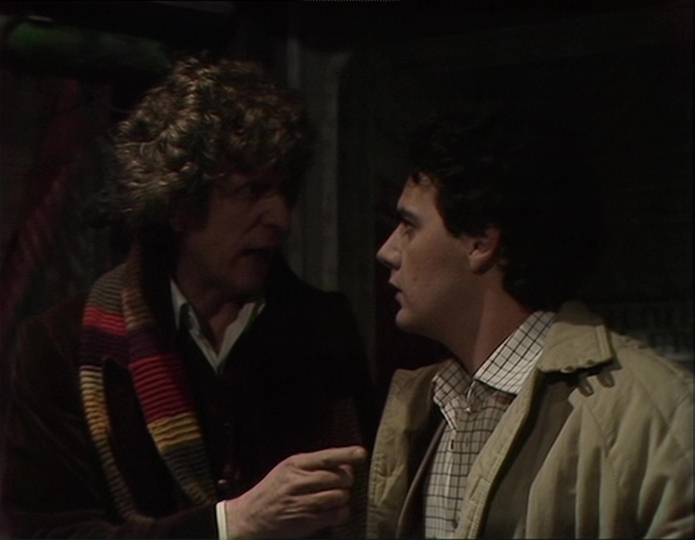
1:28:53 - K9 tries to hold back the Krarg
• CHARLES NORTON:
As previously mentioned, I was keen to avoid frequent inter-cutting between live action and animation. I wanted to manage the transitions as best we could, to provide the most seamless experience practical. That presented some interesting problems to solve with this section. All of the stuff of the Doctor and Chris on the Think Tank was shot back in 1979. In fact, it was the very last material to be completed on Shada, as part of the original studio shoot on 5th November 1979. However, as scripted, all of these scenes on the Think Tank were meant to inter-cut with scenes of K9 holding back the Krarg, back on Skagra's ship. The original production team planned to shoot the material of K9 and the Krarg on 19th November 1979. However, that studio day was cancelled and so none of that footage was ever shot.
So, how come you are now watching live-action footage of K9 holding back that Krarg? Well, we shot it all in 2017.
Shooting this material in 2017 came with a few problems that needed to be overcome. Most important of which was simply a matter of visual consistency. We knew we'd be cutting directly into 1979 VT material here. Consequently, anything that we shot in 2017 had to look (as far as possible) exactly like what they had shot back in 1979. And we had to go to quite some lengths to achieve this.
The starting point was a single photograph taken by the original production team in studio TC6 at Television Centre on 19th November 1979. This was the day that they'd originally planned to shoot the scene of K9 and the Krarg. The photograph shows the set for Chris' lab under construction, with the Police Box prop standing to one side and a camera crane in front. The TARDIS interior set is next to the lab. However, if you look very closely, you can also see something else. Hanging from the studio lighting rig, there are several metal scenic panels. They are made out of embossed metal. And anyone who's seen a decent enough number of 1970s and 1980s Doctor Who episodes will instantly recognise them.
These particular metal panels were used as set-dressing in various Doctor Who stories throughout the 70s and 80s. They pretty were much always used to represent the walls of particular rough-looking spaceships. You see them most prominently in The Horns of Nimon (1979), Warriors' Gate and Terminus (1983). And, if you squint into the gloom, you can also see them being used as set elements in Ridley Scott’s 1979 epic, Alien as well.
So what are they doing in studio TC6 on 19th November 1979? Well, they're clearly waiting to be used as set-dressing for one of the scenes they were planning on shooting that day. But which scene? Well, I could be wrong, but the most likely candidate has got to be the material of K9 fighting back the Krarg. There are no set-plans to confirm this. However, as they'd only ever have been tight insert shots, they wouldn't have needed much of a set anyway.
So, great, we know what the set would have looked like, had they shot this material back in 1979. How does that help us? Well, I asked Mike Tucker how hard it might be to build some replicas of these wall panels. And much to my surprise, he told me that it probably wouldn't be necessary. He was fairly sure that the original panels were still in existence anyway. Mike felt that the production would have originally hired the panels from a prop hire company called Trading Post - and Trading Post are still very much around today.
So, Mike went down there to their London premises and sure enough, he was able to locate the exact same metal panels that we had in our 1979 photo. So, we hired (or rather re-hired) the panels. This allowed us to now rebuild the set, exactly as it would have been back in 1979, had they actually been able to shoot all this material as originally planned.
However, what about the two protagonists of the scene - K9 and the Krarg. Well, K9 was easy. The original 1977 K9 prop was never actually retired by the BBC. It's very much still a working prop and is still wheeled out from time to time (albeit not all that much in the last decade). The K9 you see on screen with David Tennant and Matt Smith is the exact same prop as was used back in the 1970s with Tom Baker. And it's been kept very well maintained over the years to allow for this. Mat Irvine (who has been K9's chief operator since 1980) was also happy to come in to operate the dog for our shoot.
But what about the Krarg? Well again, via Mike's contacts, we were also able to trace one of the original 1979 Krarg costumes in the hands of collector, Roger Dilley. The costume didn't have a head anymore, but as we were only going to be shooting our footage at K9's level (close to the floor), there was no real need to see the Krarg's head anyway. Sadly, the Krarg costume was not in the best of condition. A lot of the glue had dried out, causing bits of the costume to curl and crumble. No fault of the costume's current owner, I hasten to add. It was just down to age. The costume was never made to last this long. We brought in veteran Doctor Who creature effects artist Robert Allsopp to refurbish the Krarg for us at his London workshop. This chiefly involved making new scales for the costume and Richard Bignell took on the task of actually transporting the costume from the owner’s home (in Kent) up to the workshop in London.
• RICHARD BIGNELL:
On Wednesday 7 June, my inbox pinged with a strange request from Charles. Knowing that I lived in Kent, Charles asked if I would be willing help out by travelling down to the seaside town of Whitstable to collect an original Krarg costume (or at least the bottom half of one) from Roger Dilley. The costume would then need to be transported up to the workshop of costume and prop specialist, Robert Allsopp in south-east London, where it would then undergo refurbishment so that it could be eventually be used to shoot a number of short live-action sequences set on the Think-Tank station of K9 attacking the monster.
Roger had obtained his part-Krarg at the BBC Television Costume Sale held at Bonhams on 6 August 1990, where instead of auctioning off individual items, various costumes were grouped together in larger job lots. Roger had originally assumed that the Krarg costume was complete when he bought it, but when he went to collect his items, he found that it sadly wasn’t the case. For some reason, the top part of the costume and the gloves had been split off into a separate lot by the auction house. Roger managed to persuade Bonhams to reunite the gloves with the main body suit that he had purchased, but they wouldn’t agree to including the head as well, so the two halves went their separate ways.
Saturday 17th June was a blisteringly hot day, and on arriving in Whitstable, I was met by a happy and cheerful Roger, who brought out of his garage the lower half of his Krarg costume. Poor Mr. Krarg was not in a particularly happy state though. The ‘crystalline’ plates attached to the under-suit that made up the outer surface of the creature were actually made from thin sheets of grey foam, which had become dry and crumbly with age. In many cases, these had begun to separate from the surface material that had been placed over them, much of which had turned an odd shade of dishcloth-blue over time. We wrapped the slightly odorous costume in black bin bags to keep everything together and loaded it into the back of my car.
After a sweltering, traffic jam-laden journey back up the M2/A2 to London, I finally arrived in Woodside only to find that parking was going to be something of an issue. After driving around for a while, I managed to find a space some way away, so after making contact with Charles, who was overseeing the delivery, between us we carried the costume through the London streets back to the workshop. Goodness only knows what the residents thought we were doing as we carried the black bag wrapped carcass past their houses…
• CHARLES NORTON:
The restored costume (which we suspect no actor had ever actually worn before) was a huge improvement and more than adequate for the limited action we needed it to perform.
So, we now had the original set, the original Krarg and the original K9, ready to shoot our new material. That just left us having to find a studio space to shoot it in and camera to shoot it with.
In 1979, Doctor Who was using tube-based pedestal cameras for all their VT studio work. There were three main cameras in use at BBC Television Centre at this time. The first of these was the EMI 2001, a beautifully engineered four-tube camera made by EMI, which had been in use ever since the BBC switched to full colour broadcasting in 1969. For a while these cameras remained the only colour studio cameras in mainstream use at the BBC. However, then, in the second half of the 1970s, the BBC started to introduce a second type of camera, the three-tube Link 110. Not quite as good as the EMI 2001, but still a very sound camera, it helped supplement the then ageing stock of EMI 2001s. Both cameras remained in use all the way up to the end of the 1980s (and a tiny bit beyond in some cases). Any 70s or 80s Doctor Who story you've ever seen will have (in whole or part) have been shot using at least one of these two cameras. The third type of studio camera that was sometimes used on Doctor Who in the 70s and 80s was the Ikegami 79 series camera. There were a few different variants of these. The earliest dated to about 1977. The tubes in the Ikegami cameras were not very large and so the image quality wasn't amazing. However, the big advantage they had over the EMI and Link cameras was their portability. The Ikegami cameras could be mounted to a camera pedestal (just like the EMI and Link cameras). However, they were also designed to be carried around (normally on the shoulder). This allowed you to get some truly fluid hand-held shots on VT, in a way that had never really been possible before.
We know that the EMI cameras were used a lot in the studio on Shada, in the scenes shot in studio TC3. However, we're not really sure what cameras they'd have used when the shoot moved to studio TC6. It would probably have been mostly done on Link or EMI cameras. However, we can't really rule out the idea that Pennant Roberts might also have done some stuff on Ikegami. We know the Ikegami was used on a few Doctor Who stories made the year after Shada, being extensively used for Season 18 during the making of The Leisure Hive, Meglos and Warriors' Gate. We suspect it might also have been used to shoot some material in Destiny of the Daleks (1979), which would mark its very first use on the show (It's possible that Destiny of the Daleks instead used the Ikegami HL77, which was the precursor to the Ikegami 79 series. We really don't know though. None of the production paperwork makes any indication one way or the other). The camera remained in use on Doctor Who throughout the 1980s - especially on The Caves of Androzani (1984) and Battlefield (1989). So really, any of these three cameras might have used to complete Shada had production managed to conclude as planned back in either 1979 or 1980.
Of course, in 2017, we found ourselves working in a very different TV production landscape to the one the original crew were in. In 2017 none of the three studio cameras I mention had been in any kind of mainstream usage for decades, which made hiring one for our Shada shoot a little less than straightforward. But also not totally impossible.
Sadly, shooting on either an EMI 2001 or a Link 110 had to be ruled out completely. The supporting technology infrastructure needed to run those cameras simply isn't there anymore. They were an integral part of the studios into which they were installed and without that original 1970s studio connected to the back of the camera, the camera just doesn't work. However, I did know of a company from where we could hire some Ikegami cameras. That company was Golden Age TV Ltd., run by Doctor Who Magazine comic artist and veteran BBC television camera operator, Dicky Howett and it was his cameras that we ended up using to shoot our Krarg and K9 material, with Dicky himself as camera operator.
• DICKY HOWETT:
We used a genuine 1980 Ikegami 79E three tube analogue colour camera. This camera (still in operating condition) was used originally by Welsh facilities company Barcued, with additions (on the Shada filming day) of a zoom lens from Teddington Studios (formerly home to Thames Television) and a viewfinder from BBC Television Centre Studio TC7. The camera body was resplendent with sticker badges from ABC TV News and Television South West. The camera pedestal was my Vinten Midi Pedestel, also from Teddington Studios. Since then the Ikegami camera has filmed scenes for Charlie Brooker’s Black Mirror: Bandersnatch (2018).
• CHARLES NORTON:
We shot the K9 and Krarg scenes (with Barnaby Edwards in the Krarg suit) on 13th September 2017 at IMG Studios in Uxbridge.
Of course, this was a quite spectacular amount of work to go to for just a few seconds of footage of K9 and a Krarg. However, it wasn't only this footage that we planned to shoot with this equipment. Both the camera and the studio would be used to create other new live-action VT material too. Of which, more later...
As previously mentioned, I was keen to avoid frequent inter-cutting between live action and animation. I wanted to manage the transitions as best we could, to provide the most seamless experience practical. That presented some interesting problems to solve with this section. All of the stuff of the Doctor and Chris on the Think Tank was shot back in 1979. In fact, it was the very last material to be completed on Shada, as part of the original studio shoot on 5th November 1979. However, as scripted, all of these scenes on the Think Tank were meant to inter-cut with scenes of K9 holding back the Krarg, back on Skagra's ship. The original production team planned to shoot the material of K9 and the Krarg on 19th November 1979. However, that studio day was cancelled and so none of that footage was ever shot.
So, how come you are now watching live-action footage of K9 holding back that Krarg? Well, we shot it all in 2017.
Shooting this material in 2017 came with a few problems that needed to be overcome. Most important of which was simply a matter of visual consistency. We knew we'd be cutting directly into 1979 VT material here. Consequently, anything that we shot in 2017 had to look (as far as possible) exactly like what they had shot back in 1979. And we had to go to quite some lengths to achieve this.
The starting point was a single photograph taken by the original production team in studio TC6 at Television Centre on 19th November 1979. This was the day that they'd originally planned to shoot the scene of K9 and the Krarg. The photograph shows the set for Chris' lab under construction, with the Police Box prop standing to one side and a camera crane in front. The TARDIS interior set is next to the lab. However, if you look very closely, you can also see something else. Hanging from the studio lighting rig, there are several metal scenic panels. They are made out of embossed metal. And anyone who's seen a decent enough number of 1970s and 1980s Doctor Who episodes will instantly recognise them.
These particular metal panels were used as set-dressing in various Doctor Who stories throughout the 70s and 80s. They pretty were much always used to represent the walls of particular rough-looking spaceships. You see them most prominently in The Horns of Nimon (1979), Warriors' Gate and Terminus (1983). And, if you squint into the gloom, you can also see them being used as set elements in Ridley Scott’s 1979 epic, Alien as well.
So what are they doing in studio TC6 on 19th November 1979? Well, they're clearly waiting to be used as set-dressing for one of the scenes they were planning on shooting that day. But which scene? Well, I could be wrong, but the most likely candidate has got to be the material of K9 fighting back the Krarg. There are no set-plans to confirm this. However, as they'd only ever have been tight insert shots, they wouldn't have needed much of a set anyway.
So, great, we know what the set would have looked like, had they shot this material back in 1979. How does that help us? Well, I asked Mike Tucker how hard it might be to build some replicas of these wall panels. And much to my surprise, he told me that it probably wouldn't be necessary. He was fairly sure that the original panels were still in existence anyway. Mike felt that the production would have originally hired the panels from a prop hire company called Trading Post - and Trading Post are still very much around today.
So, Mike went down there to their London premises and sure enough, he was able to locate the exact same metal panels that we had in our 1979 photo. So, we hired (or rather re-hired) the panels. This allowed us to now rebuild the set, exactly as it would have been back in 1979, had they actually been able to shoot all this material as originally planned.
However, what about the two protagonists of the scene - K9 and the Krarg. Well, K9 was easy. The original 1977 K9 prop was never actually retired by the BBC. It's very much still a working prop and is still wheeled out from time to time (albeit not all that much in the last decade). The K9 you see on screen with David Tennant and Matt Smith is the exact same prop as was used back in the 1970s with Tom Baker. And it's been kept very well maintained over the years to allow for this. Mat Irvine (who has been K9's chief operator since 1980) was also happy to come in to operate the dog for our shoot.
But what about the Krarg? Well again, via Mike's contacts, we were also able to trace one of the original 1979 Krarg costumes in the hands of collector, Roger Dilley. The costume didn't have a head anymore, but as we were only going to be shooting our footage at K9's level (close to the floor), there was no real need to see the Krarg's head anyway. Sadly, the Krarg costume was not in the best of condition. A lot of the glue had dried out, causing bits of the costume to curl and crumble. No fault of the costume's current owner, I hasten to add. It was just down to age. The costume was never made to last this long. We brought in veteran Doctor Who creature effects artist Robert Allsopp to refurbish the Krarg for us at his London workshop. This chiefly involved making new scales for the costume and Richard Bignell took on the task of actually transporting the costume from the owner’s home (in Kent) up to the workshop in London.
• RICHARD BIGNELL:
On Wednesday 7 June, my inbox pinged with a strange request from Charles. Knowing that I lived in Kent, Charles asked if I would be willing help out by travelling down to the seaside town of Whitstable to collect an original Krarg costume (or at least the bottom half of one) from Roger Dilley. The costume would then need to be transported up to the workshop of costume and prop specialist, Robert Allsopp in south-east London, where it would then undergo refurbishment so that it could be eventually be used to shoot a number of short live-action sequences set on the Think-Tank station of K9 attacking the monster.
Roger had obtained his part-Krarg at the BBC Television Costume Sale held at Bonhams on 6 August 1990, where instead of auctioning off individual items, various costumes were grouped together in larger job lots. Roger had originally assumed that the Krarg costume was complete when he bought it, but when he went to collect his items, he found that it sadly wasn’t the case. For some reason, the top part of the costume and the gloves had been split off into a separate lot by the auction house. Roger managed to persuade Bonhams to reunite the gloves with the main body suit that he had purchased, but they wouldn’t agree to including the head as well, so the two halves went their separate ways.
Saturday 17th June was a blisteringly hot day, and on arriving in Whitstable, I was met by a happy and cheerful Roger, who brought out of his garage the lower half of his Krarg costume. Poor Mr. Krarg was not in a particularly happy state though. The ‘crystalline’ plates attached to the under-suit that made up the outer surface of the creature were actually made from thin sheets of grey foam, which had become dry and crumbly with age. In many cases, these had begun to separate from the surface material that had been placed over them, much of which had turned an odd shade of dishcloth-blue over time. We wrapped the slightly odorous costume in black bin bags to keep everything together and loaded it into the back of my car.
After a sweltering, traffic jam-laden journey back up the M2/A2 to London, I finally arrived in Woodside only to find that parking was going to be something of an issue. After driving around for a while, I managed to find a space some way away, so after making contact with Charles, who was overseeing the delivery, between us we carried the costume through the London streets back to the workshop. Goodness only knows what the residents thought we were doing as we carried the black bag wrapped carcass past their houses…
• CHARLES NORTON:
The restored costume (which we suspect no actor had ever actually worn before) was a huge improvement and more than adequate for the limited action we needed it to perform.
So, we now had the original set, the original Krarg and the original K9, ready to shoot our new material. That just left us having to find a studio space to shoot it in and camera to shoot it with.
In 1979, Doctor Who was using tube-based pedestal cameras for all their VT studio work. There were three main cameras in use at BBC Television Centre at this time. The first of these was the EMI 2001, a beautifully engineered four-tube camera made by EMI, which had been in use ever since the BBC switched to full colour broadcasting in 1969. For a while these cameras remained the only colour studio cameras in mainstream use at the BBC. However, then, in the second half of the 1970s, the BBC started to introduce a second type of camera, the three-tube Link 110. Not quite as good as the EMI 2001, but still a very sound camera, it helped supplement the then ageing stock of EMI 2001s. Both cameras remained in use all the way up to the end of the 1980s (and a tiny bit beyond in some cases). Any 70s or 80s Doctor Who story you've ever seen will have (in whole or part) have been shot using at least one of these two cameras. The third type of studio camera that was sometimes used on Doctor Who in the 70s and 80s was the Ikegami 79 series camera. There were a few different variants of these. The earliest dated to about 1977. The tubes in the Ikegami cameras were not very large and so the image quality wasn't amazing. However, the big advantage they had over the EMI and Link cameras was their portability. The Ikegami cameras could be mounted to a camera pedestal (just like the EMI and Link cameras). However, they were also designed to be carried around (normally on the shoulder). This allowed you to get some truly fluid hand-held shots on VT, in a way that had never really been possible before.
We know that the EMI cameras were used a lot in the studio on Shada, in the scenes shot in studio TC3. However, we're not really sure what cameras they'd have used when the shoot moved to studio TC6. It would probably have been mostly done on Link or EMI cameras. However, we can't really rule out the idea that Pennant Roberts might also have done some stuff on Ikegami. We know the Ikegami was used on a few Doctor Who stories made the year after Shada, being extensively used for Season 18 during the making of The Leisure Hive, Meglos and Warriors' Gate. We suspect it might also have been used to shoot some material in Destiny of the Daleks (1979), which would mark its very first use on the show (It's possible that Destiny of the Daleks instead used the Ikegami HL77, which was the precursor to the Ikegami 79 series. We really don't know though. None of the production paperwork makes any indication one way or the other). The camera remained in use on Doctor Who throughout the 1980s - especially on The Caves of Androzani (1984) and Battlefield (1989). So really, any of these three cameras might have used to complete Shada had production managed to conclude as planned back in either 1979 or 1980.
Of course, in 2017, we found ourselves working in a very different TV production landscape to the one the original crew were in. In 2017 none of the three studio cameras I mention had been in any kind of mainstream usage for decades, which made hiring one for our Shada shoot a little less than straightforward. But also not totally impossible.
Sadly, shooting on either an EMI 2001 or a Link 110 had to be ruled out completely. The supporting technology infrastructure needed to run those cameras simply isn't there anymore. They were an integral part of the studios into which they were installed and without that original 1970s studio connected to the back of the camera, the camera just doesn't work. However, I did know of a company from where we could hire some Ikegami cameras. That company was Golden Age TV Ltd., run by Doctor Who Magazine comic artist and veteran BBC television camera operator, Dicky Howett and it was his cameras that we ended up using to shoot our Krarg and K9 material, with Dicky himself as camera operator.
• DICKY HOWETT:
We used a genuine 1980 Ikegami 79E three tube analogue colour camera. This camera (still in operating condition) was used originally by Welsh facilities company Barcued, with additions (on the Shada filming day) of a zoom lens from Teddington Studios (formerly home to Thames Television) and a viewfinder from BBC Television Centre Studio TC7. The camera body was resplendent with sticker badges from ABC TV News and Television South West. The camera pedestal was my Vinten Midi Pedestel, also from Teddington Studios. Since then the Ikegami camera has filmed scenes for Charlie Brooker’s Black Mirror: Bandersnatch (2018).
• CHARLES NORTON:
We shot the K9 and Krarg scenes (with Barnaby Edwards in the Krarg suit) on 13th September 2017 at IMG Studios in Uxbridge.
Of course, this was a quite spectacular amount of work to go to for just a few seconds of footage of K9 and a Krarg. However, it wasn't only this footage that we planned to shoot with this equipment. Both the camera and the studio would be used to create other new live-action VT material too. Of which, more later...
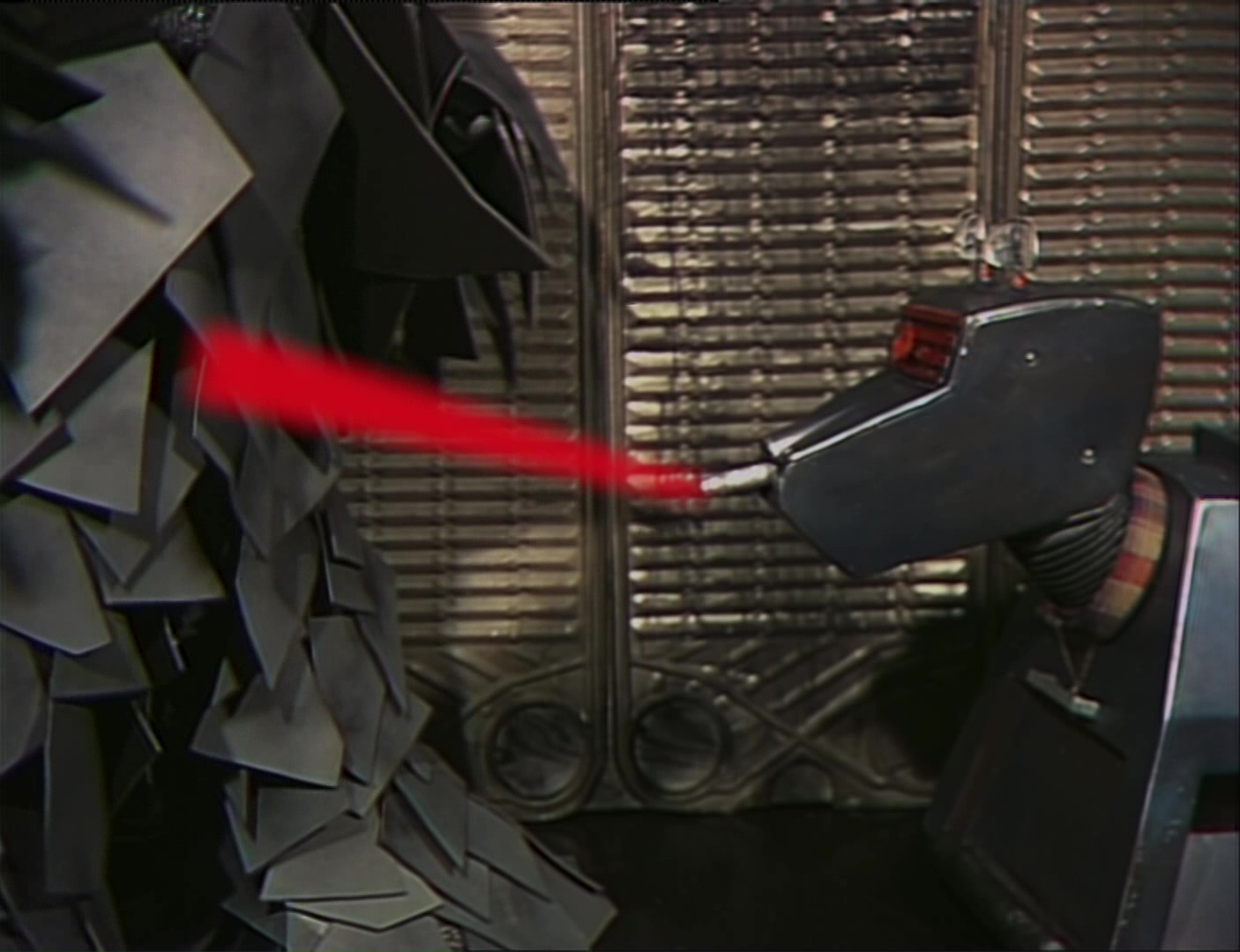
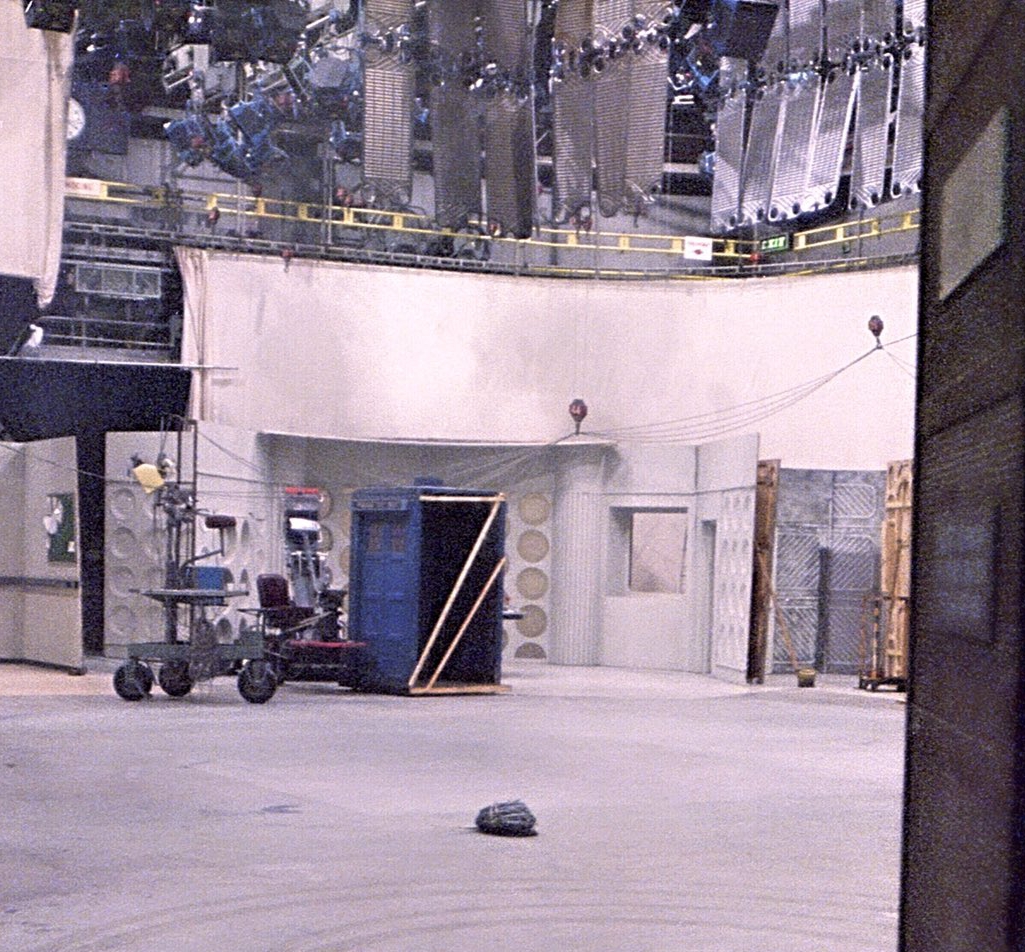

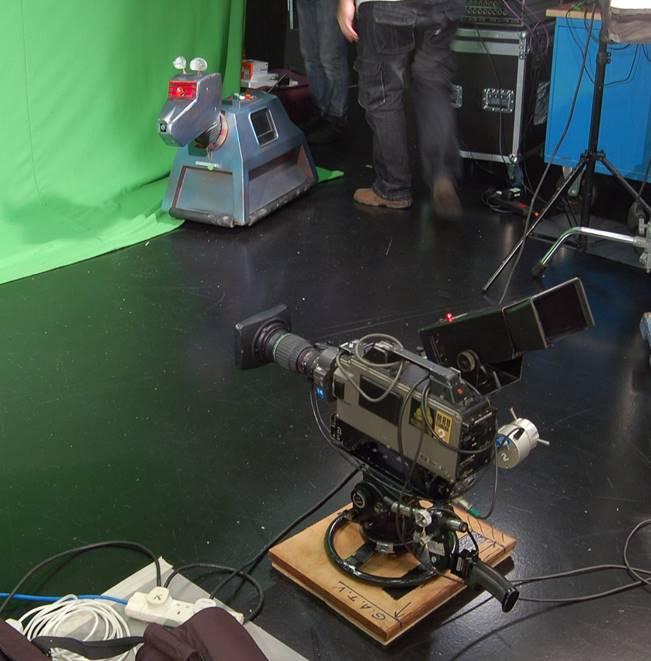
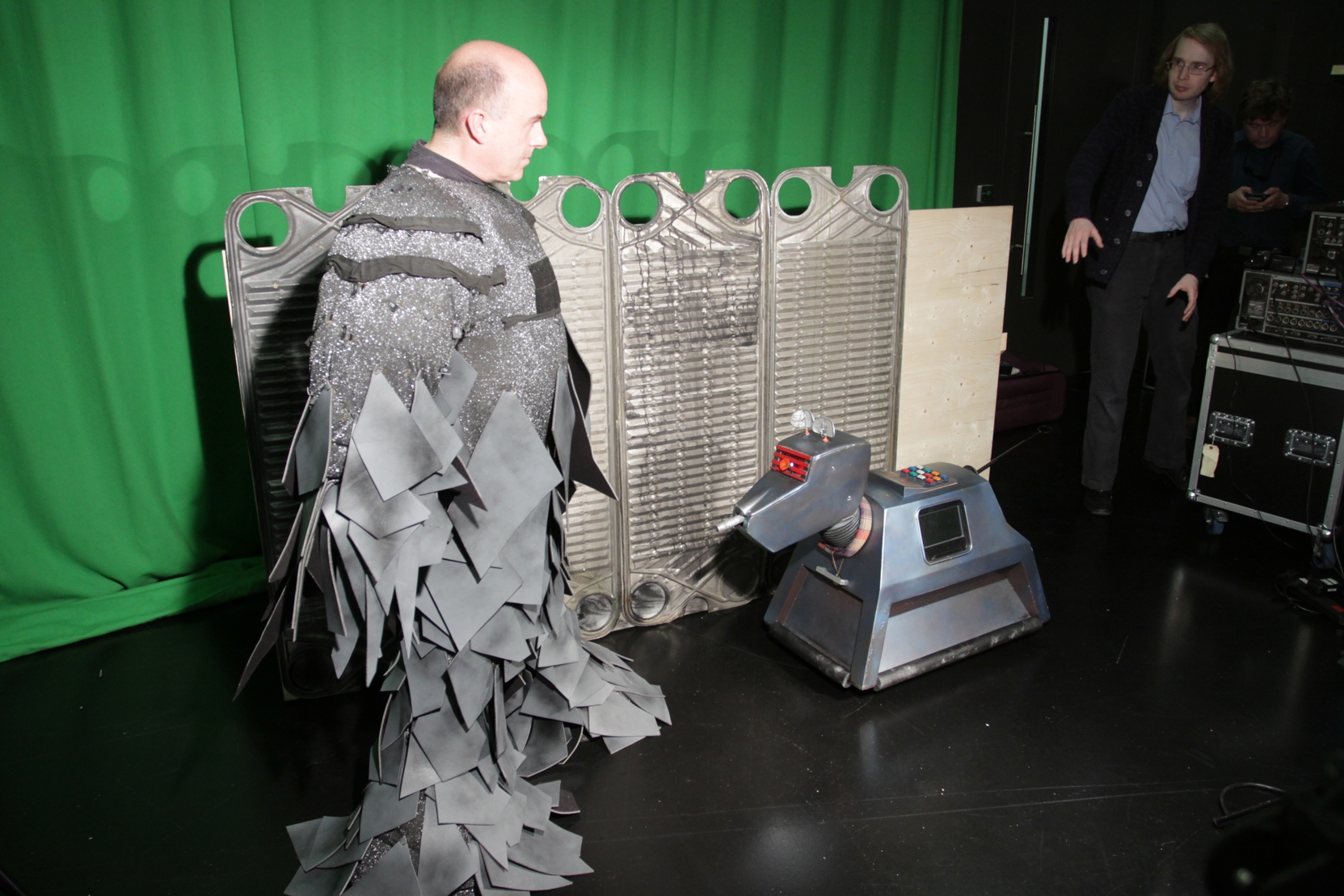
The Ikegami 79 camera with the original K9 at IMG Studios, Uxbridge on 13th September 2017 (Image © Dicky Howett)
1:32:59 - The Krarg marches off
• CHARLES NORTON:
We used a red lighting gel to suggest the Krarg was getting hotter. We suspect that in 1979, they were planning to use Front Axial Projection to convey the same effect. However, that would have needed two separate Krarg costumes (one ordinary one and one covered in FAP material). And we only had the one costume.
At 1:33:10, BBC America go to their next ad break.
We used a red lighting gel to suggest the Krarg was getting hotter. We suspect that in 1979, they were planning to use Front Axial Projection to convey the same effect. However, that would have needed two separate Krarg costumes (one ordinary one and one covered in FAP material). And we only had the one costume.
At 1:33:10, BBC America go to their next ad break.
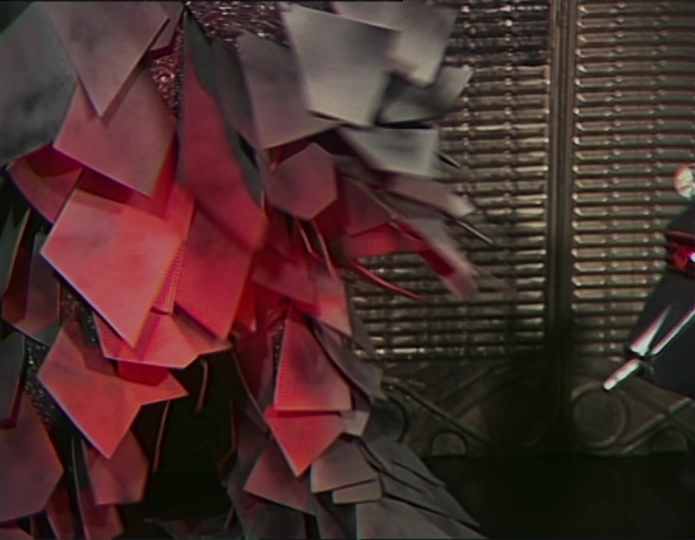
1:33:40 - The Krarg smashes its cattle prod against the wall
• CHARLES NORTON:
The sparks that are produced when that Krarg pole hits the wall were added on over the top of the footage by us in post-production. They would have done the same thing back in 1979 too, had post-production ever advanced that far. However, we don't know how they'd have created the sparks. We used some live-action footage of real sparks, rather than anything digitally created. Peter Crocker handled the compositing work in Adobe Premiere Pro.
The sparks that are produced when that Krarg pole hits the wall were added on over the top of the footage by us in post-production. They would have done the same thing back in 1979 too, had post-production ever advanced that far. However, we don't know how they'd have created the sparks. We used some live-action footage of real sparks, rather than anything digitally created. Peter Crocker handled the compositing work in Adobe Premiere Pro.
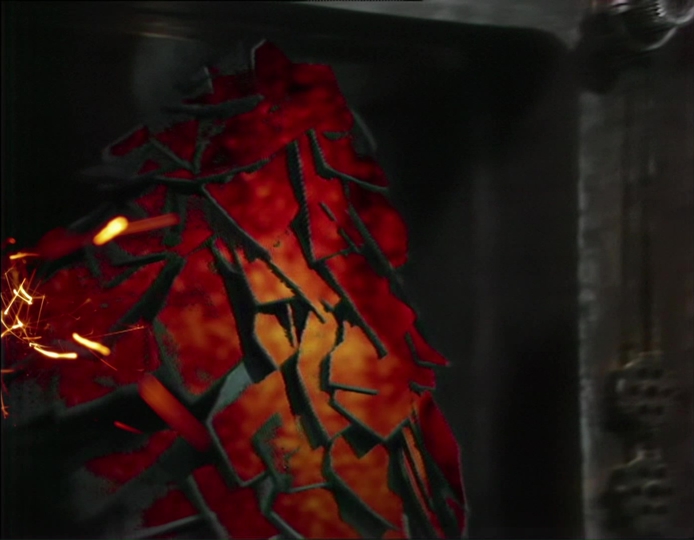
1:36:00 - The Doctor, Chris and K9 escape through the airlock
• CHARLES NORTON:
This shot of the bulkhead door descending in front of the Krarg was the last shot to be completed as part of Shada's original production block on 5th November 1979. Consequently, it was also the very last piece of Doctor Who to be shot in the whole of the 1970s. No more Doctor Who would be filmed until 20th March 1980, the first day of principal photography on The Leisure Hive, by which time Doctor Who was being made by a near-completely new production team. Shada itself wouldn't go back before the cameras until 8th August 2017, when we resumed filming at Halliford Studios in Shepperton, nearly 38 years on from that last November shooting day in studio TC3. That's quite a gap in the shooting schedule.
This shot of the bulkhead door descending in front of the Krarg was the last shot to be completed as part of Shada's original production block on 5th November 1979. Consequently, it was also the very last piece of Doctor Who to be shot in the whole of the 1970s. No more Doctor Who would be filmed until 20th March 1980, the first day of principal photography on The Leisure Hive, by which time Doctor Who was being made by a near-completely new production team. Shada itself wouldn't go back before the cameras until 8th August 2017, when we resumed filming at Halliford Studios in Shepperton, nearly 38 years on from that last November shooting day in studio TC3. That's quite a gap in the shooting schedule.
1:36:03 - The Doctor doesn't order the ship to take off
• CHARLES NORTON:
Another extremely short trim here. As originally scripted, there was a very brief scene of the Doctor running into Skagra's ship and ordering it to take off. This scene would have been only a very few seconds and would have slotted in between the bulkhead door closing and the model shot of the Think Tank. We decided not to record this scene, in order to up the suspense and retain visual consistency in the live-action footage.
Another extremely short trim here. As originally scripted, there was a very brief scene of the Doctor running into Skagra's ship and ordering it to take off. This scene would have been only a very few seconds and would have slotted in between the bulkhead door closing and the model shot of the Think Tank. We decided not to record this scene, in order to up the suspense and retain visual consistency in the live-action footage.
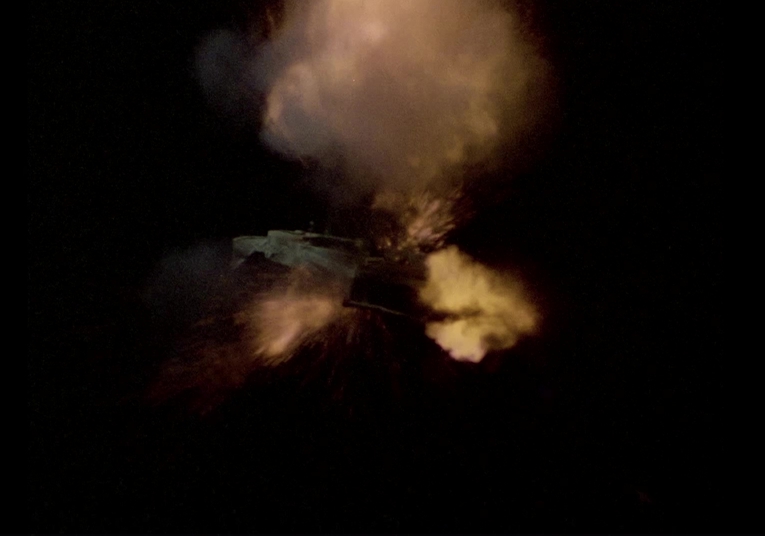
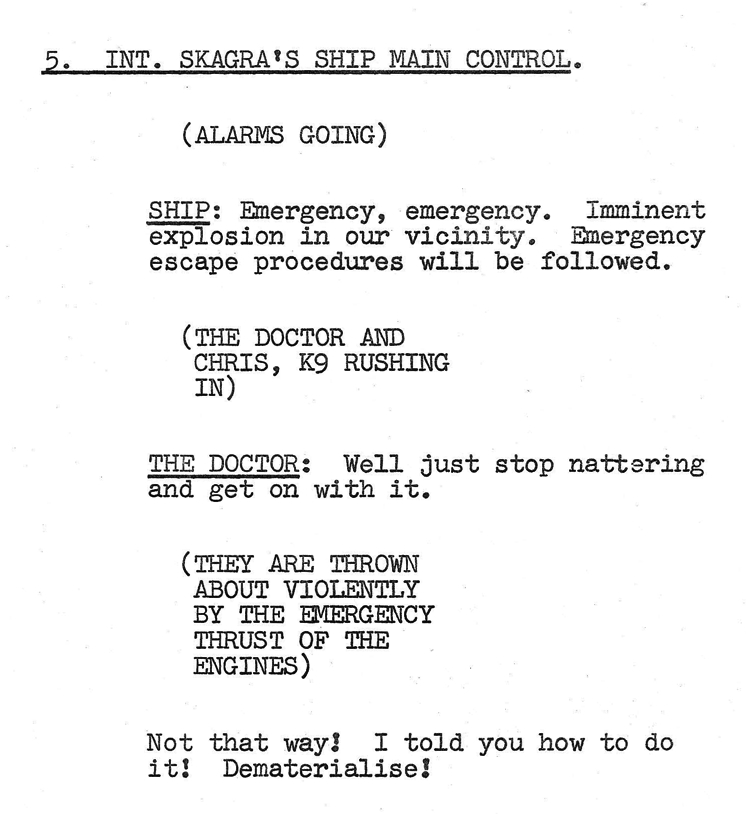
1:36:12 - The Think Tank explodes
• CHARLES NORTON:
This footage of the Think Tank exploding was the one and only miniature effects shot to be filmed as part of Shada's original production block back in 1979. Which is a bit strange actually. It meant that they must have built two completely different miniatures of the Think Tank. One to blow up and then one to use for all the other effects shots later on. Why would you do that? Why not just build one? Shoot all of the Think Tank effects shots you need for the whole story and then film the explosion last. Does that not make sense? It's really odd. None of us have yet been able to figure out quite why they did it the way they did. It would have cost them more money and wasted the best part of an entire day that they could have used to film all sorts of great stuff on the stage at Ealing Film Studios. Is it because this was the only shot that they couldn't safely achieve in the studios at Television Centre? Maybe so, but if you've got a model of the Think Tank and a film studio to film it in, why not film all the material you need then and there? Why wait until a few weeks later when you're at Television Centre, with inferior cameras, less time and fewer appropriate resources? Something similar happened with the production of The Horns of Nimon, which was shot a few weeks before Shada. Was Graham Williams just not very good at planning out visual effects shoots? Or are we being unfair and missing something really obvious? I suspect it's the second option, but I'm open to suggestions.
Incidentally, if you watch carefully, you'll see that this explosion scene is made up of three separate bits of film (implying the use of two cameras). Oddly, when the surviving scenes from Shada were brought together for a special compilation presentation from BBC Video in 1992, only two of these three shots were actually included in the compilation, meaning that there was a jump-cut mid-sequence. What appears to have happened is that the scene was shot on 16mm film and was accordingly stored on two rolls of film - an A roll and a B roll. When the video compilation was put together in 1992, only the A roll was sent to the edit suite. The A roll only contained shots 1 and 3, with a black space in the middle for shot 2. They did their best on the day and just joined the two shots together. It seems that when we called up the film negatives in 2017, we were the first people to ever actually watch the footage of shot 2. Or at least, the first people outside of the lab that processed the film back in 1979.
• RICHARD BIGNELL:
Further to Charles' comment, the production paperwork for Shada actually indicates that Visual Effects actually constructed not one, but two additional copies of the Think Tank model so that it could be blown up during the filming day at Ealing Studios.
This footage of the Think Tank exploding was the one and only miniature effects shot to be filmed as part of Shada's original production block back in 1979. Which is a bit strange actually. It meant that they must have built two completely different miniatures of the Think Tank. One to blow up and then one to use for all the other effects shots later on. Why would you do that? Why not just build one? Shoot all of the Think Tank effects shots you need for the whole story and then film the explosion last. Does that not make sense? It's really odd. None of us have yet been able to figure out quite why they did it the way they did. It would have cost them more money and wasted the best part of an entire day that they could have used to film all sorts of great stuff on the stage at Ealing Film Studios. Is it because this was the only shot that they couldn't safely achieve in the studios at Television Centre? Maybe so, but if you've got a model of the Think Tank and a film studio to film it in, why not film all the material you need then and there? Why wait until a few weeks later when you're at Television Centre, with inferior cameras, less time and fewer appropriate resources? Something similar happened with the production of The Horns of Nimon, which was shot a few weeks before Shada. Was Graham Williams just not very good at planning out visual effects shoots? Or are we being unfair and missing something really obvious? I suspect it's the second option, but I'm open to suggestions.
Incidentally, if you watch carefully, you'll see that this explosion scene is made up of three separate bits of film (implying the use of two cameras). Oddly, when the surviving scenes from Shada were brought together for a special compilation presentation from BBC Video in 1992, only two of these three shots were actually included in the compilation, meaning that there was a jump-cut mid-sequence. What appears to have happened is that the scene was shot on 16mm film and was accordingly stored on two rolls of film - an A roll and a B roll. When the video compilation was put together in 1992, only the A roll was sent to the edit suite. The A roll only contained shots 1 and 3, with a black space in the middle for shot 2. They did their best on the day and just joined the two shots together. It seems that when we called up the film negatives in 2017, we were the first people to ever actually watch the footage of shot 2. Or at least, the first people outside of the lab that processed the film back in 1979.
• RICHARD BIGNELL:
Further to Charles' comment, the production paperwork for Shada actually indicates that Visual Effects actually constructed not one, but two additional copies of the Think Tank model so that it could be blown up during the filming day at Ealing Studios.
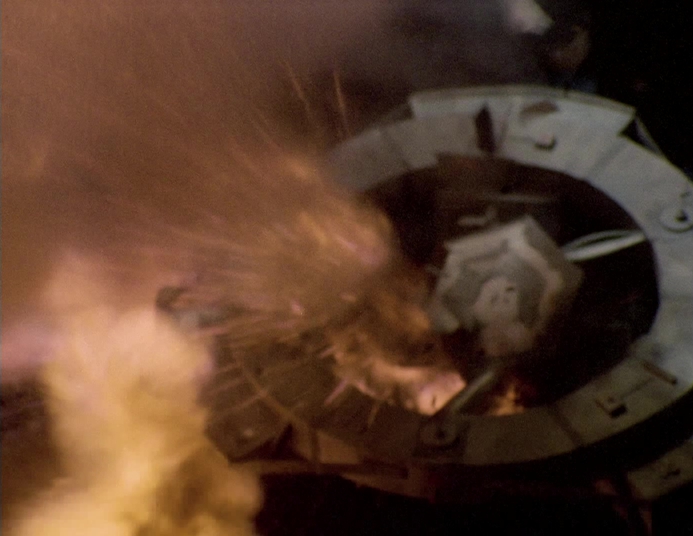
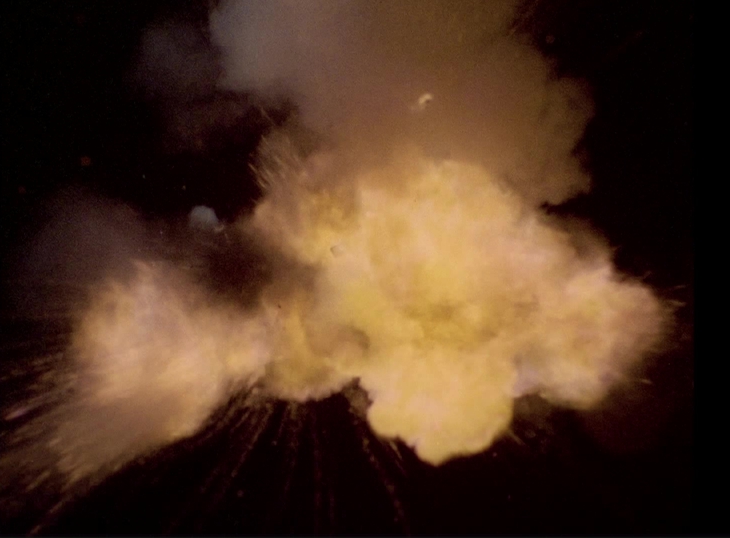

The remains of one of the orginal exploded Think Tank models came up for sale at Bonhams on 17th November 2021 as part of their Film, Rock and Pop auction. The model part failed to meet to auctioneer's estimate of £2000-3000 and remained unsold.
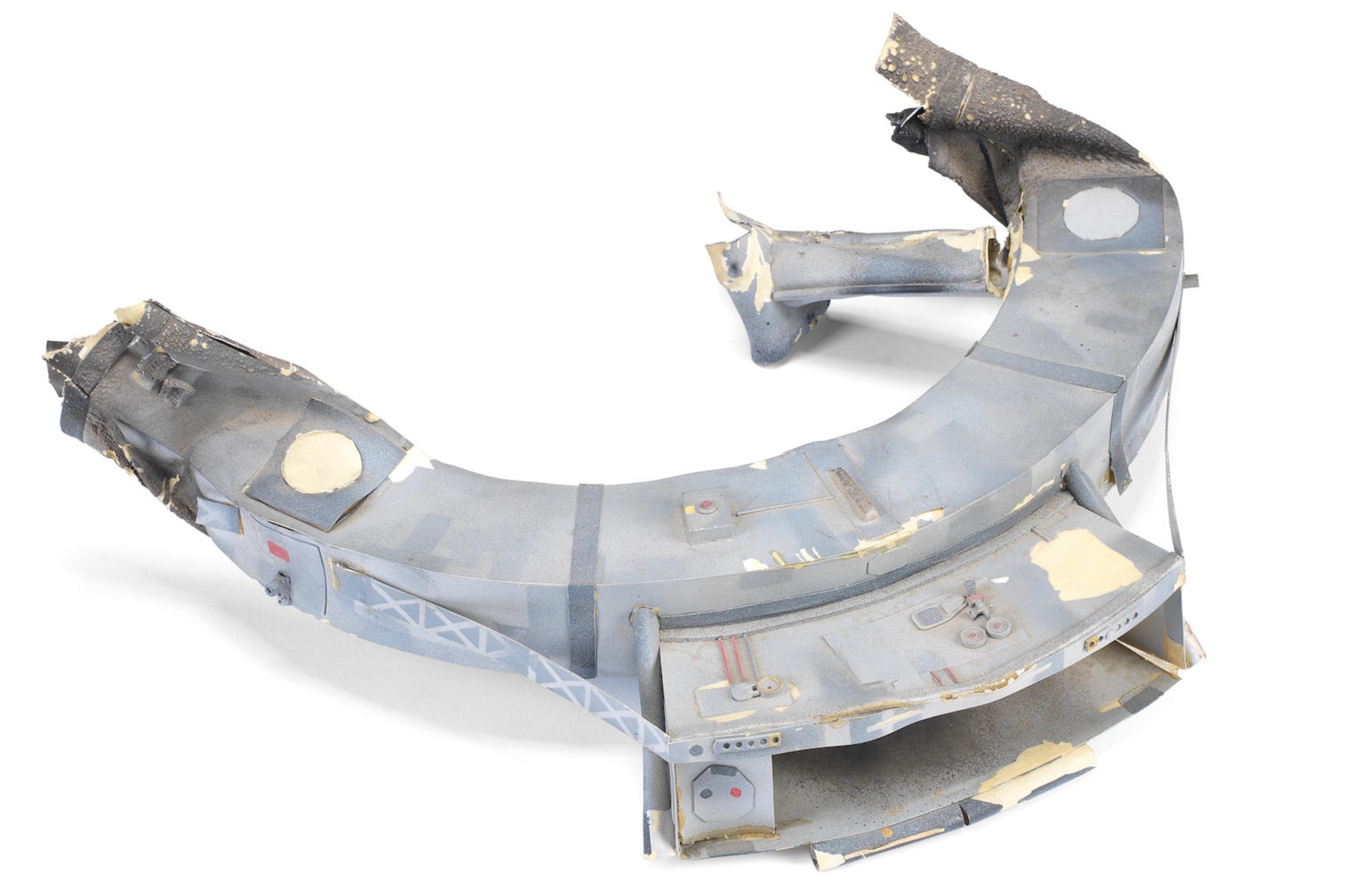
1:37:17 - The ship talks to the Doctor
• CHARLES NORTON:
Hopefully you can't tell in the final edit, but something went horribly wrong with the second half of this scene. The Doctor and Chris' dialogue was all recorded at Audio Sorcery Studios on 9th June 2017. However, the ship's audio was recorded later in the sound booth at Motivation Sound on 26th June 2017. The way things worked at Motivation Sound was that the sound engineer would save each individual take that we recorded as a separate sound file. At the end of each take, I'd call back to him in the control room to check we had it and when he confirmed that we did, I'd either move onto a retake or onto the next scene. At the end of the day’s recording, I was sent a big collection of sound files, which I could cross-reference with my recording script as I constructed a final dialogue edit for each scene. Each scene's files would have their own folder and within that folder would be all the takes of that scene, together with all the isolation tracks for that scene that were done in the sound booth. The recording for this scene of the Doctor talking to the ship saw the ship's audio done in two chunks. So, we should have had two audio files.
It was only a few days after the studio recording had concluded, while doing my edit, that I discovered that there was something wrong. I had all the isolation booth audio for the first half of the scene, but nothing for the second half. I checked all the other files, to make sure nothing had been misfiled, but it simply wasn't there. I phoned up the studio and they checked their back-ups. It wasn't there either. There was nothing. The entire take simply hadn't been recorded.
This meant that we did not have any of the computer's dialogue for the second half of the scene. Everything was missing from after the Doctor's line: "Doesn't the wretched man have a home to go to?" For that section of the scene, we effectively just had the Doctor talking to himself.
The ship had five things to say in that lost portion. And they were important things too. I couldn't just cut around them. And I didn't have enough money to bring the cast back to the studio either.
So, I went through absolutely everything we'd recorded with Shirley across the day and tired to cut and pasted together whatever I could. Just to get the ship to say something even vaguely similar to what was scripted. This was a little bit challenging. The first moment we had to worry about was where the Doctor asks the ship: "Then why didn't you tell me?" The computer was scripted to reply: "You didn't ask." Except we didn't have that audio, of course. The best fit I could find to replace the line was: "I had orders not to." Different sentence, originally recorded for a different scene, but it fitted in context.
Later on the Doctor tells the ship to take them to Skagra's home. The ship is meant to say in response: "Doctor, much of my circuitry feels uneasy about continuing to accept instructions from a dead man." Now, I couldn't find anything even remotely close to that. So I pasted in: "The order conflicts with my programmed instructions." Which actually doesn't entirely fit with the line of the Doctor's that comes next, but it was the best I could do. It mostly scans if you don't think about it too much.
The ship's final line was probably the easiest one. It was scripted as: "Instructions accepted." I couldn't find that anywhere else. However, I did have: "I obey." So I put that in instead.
Oddly enough the most difficult bit of audio to manufacture was also the shortest bit. There were two moments where the ship is scripted to reply to a question from the Doctor with a simple: "Yes." Problem is, the computer isn't scripted to use the word 'yes' in any other scene. And so, we hadn't recorded any takes containing the word either. For one of the 'yes' lines, I substituted a "correct." That worked very well. However, the intonation didn't fit with the other 'yes' line that I needed. I really needed the computer to say 'yes' properly. Just once. So I scoured the recordings again and finally found what I needed. There was a single recording near the start of the session, where you can hear my voice coming over on the talkback, as Shirley sits in the sound booth. I ask Shirley: "Are you alright in there? Do you want a glass of water?" There's a pause and Shirley replies: " Yes. Please. I'm a bit dry." And that gave me the audio of our 'yes'. Shirely even paused after the first word, allowing me to lift the word out cleanly.
So, when the computer says "yes", to the Doctor's question, it's actually audio of Shirley asking me for a glass of water. K9's line at the end of the scene is, of course, also patched in from our stock K9 tape. However, that at least, was planned. The overall result of all this eccentric editing is that the dialogue sounds a bit disjointed toward the end of this scene. However, considering how much simply wasn't there to begin with, it's really a miracle we were able to save it at all.
Hopefully you can't tell in the final edit, but something went horribly wrong with the second half of this scene. The Doctor and Chris' dialogue was all recorded at Audio Sorcery Studios on 9th June 2017. However, the ship's audio was recorded later in the sound booth at Motivation Sound on 26th June 2017. The way things worked at Motivation Sound was that the sound engineer would save each individual take that we recorded as a separate sound file. At the end of each take, I'd call back to him in the control room to check we had it and when he confirmed that we did, I'd either move onto a retake or onto the next scene. At the end of the day’s recording, I was sent a big collection of sound files, which I could cross-reference with my recording script as I constructed a final dialogue edit for each scene. Each scene's files would have their own folder and within that folder would be all the takes of that scene, together with all the isolation tracks for that scene that were done in the sound booth. The recording for this scene of the Doctor talking to the ship saw the ship's audio done in two chunks. So, we should have had two audio files.
It was only a few days after the studio recording had concluded, while doing my edit, that I discovered that there was something wrong. I had all the isolation booth audio for the first half of the scene, but nothing for the second half. I checked all the other files, to make sure nothing had been misfiled, but it simply wasn't there. I phoned up the studio and they checked their back-ups. It wasn't there either. There was nothing. The entire take simply hadn't been recorded.
This meant that we did not have any of the computer's dialogue for the second half of the scene. Everything was missing from after the Doctor's line: "Doesn't the wretched man have a home to go to?" For that section of the scene, we effectively just had the Doctor talking to himself.
The ship had five things to say in that lost portion. And they were important things too. I couldn't just cut around them. And I didn't have enough money to bring the cast back to the studio either.
So, I went through absolutely everything we'd recorded with Shirley across the day and tired to cut and pasted together whatever I could. Just to get the ship to say something even vaguely similar to what was scripted. This was a little bit challenging. The first moment we had to worry about was where the Doctor asks the ship: "Then why didn't you tell me?" The computer was scripted to reply: "You didn't ask." Except we didn't have that audio, of course. The best fit I could find to replace the line was: "I had orders not to." Different sentence, originally recorded for a different scene, but it fitted in context.
Later on the Doctor tells the ship to take them to Skagra's home. The ship is meant to say in response: "Doctor, much of my circuitry feels uneasy about continuing to accept instructions from a dead man." Now, I couldn't find anything even remotely close to that. So I pasted in: "The order conflicts with my programmed instructions." Which actually doesn't entirely fit with the line of the Doctor's that comes next, but it was the best I could do. It mostly scans if you don't think about it too much.
The ship's final line was probably the easiest one. It was scripted as: "Instructions accepted." I couldn't find that anywhere else. However, I did have: "I obey." So I put that in instead.
Oddly enough the most difficult bit of audio to manufacture was also the shortest bit. There were two moments where the ship is scripted to reply to a question from the Doctor with a simple: "Yes." Problem is, the computer isn't scripted to use the word 'yes' in any other scene. And so, we hadn't recorded any takes containing the word either. For one of the 'yes' lines, I substituted a "correct." That worked very well. However, the intonation didn't fit with the other 'yes' line that I needed. I really needed the computer to say 'yes' properly. Just once. So I scoured the recordings again and finally found what I needed. There was a single recording near the start of the session, where you can hear my voice coming over on the talkback, as Shirley sits in the sound booth. I ask Shirley: "Are you alright in there? Do you want a glass of water?" There's a pause and Shirley replies: " Yes. Please. I'm a bit dry." And that gave me the audio of our 'yes'. Shirely even paused after the first word, allowing me to lift the word out cleanly.
So, when the computer says "yes", to the Doctor's question, it's actually audio of Shirley asking me for a glass of water. K9's line at the end of the scene is, of course, also patched in from our stock K9 tape. However, that at least, was planned. The overall result of all this eccentric editing is that the dialogue sounds a bit disjointed toward the end of this scene. However, considering how much simply wasn't there to begin with, it's really a miracle we were able to save it at all.
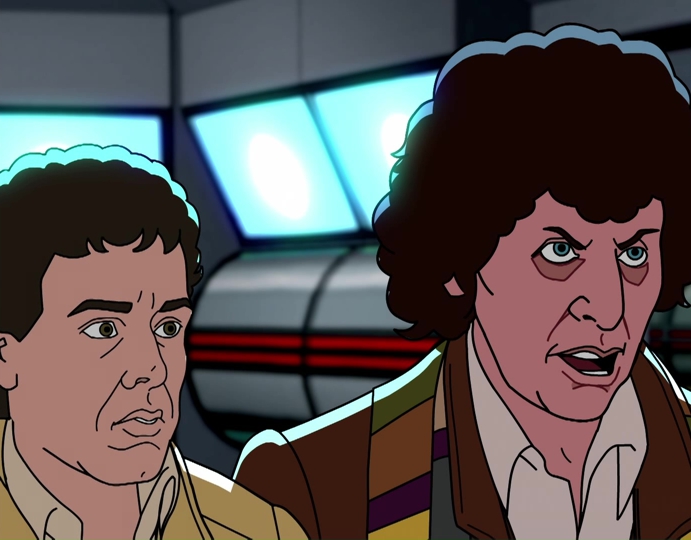
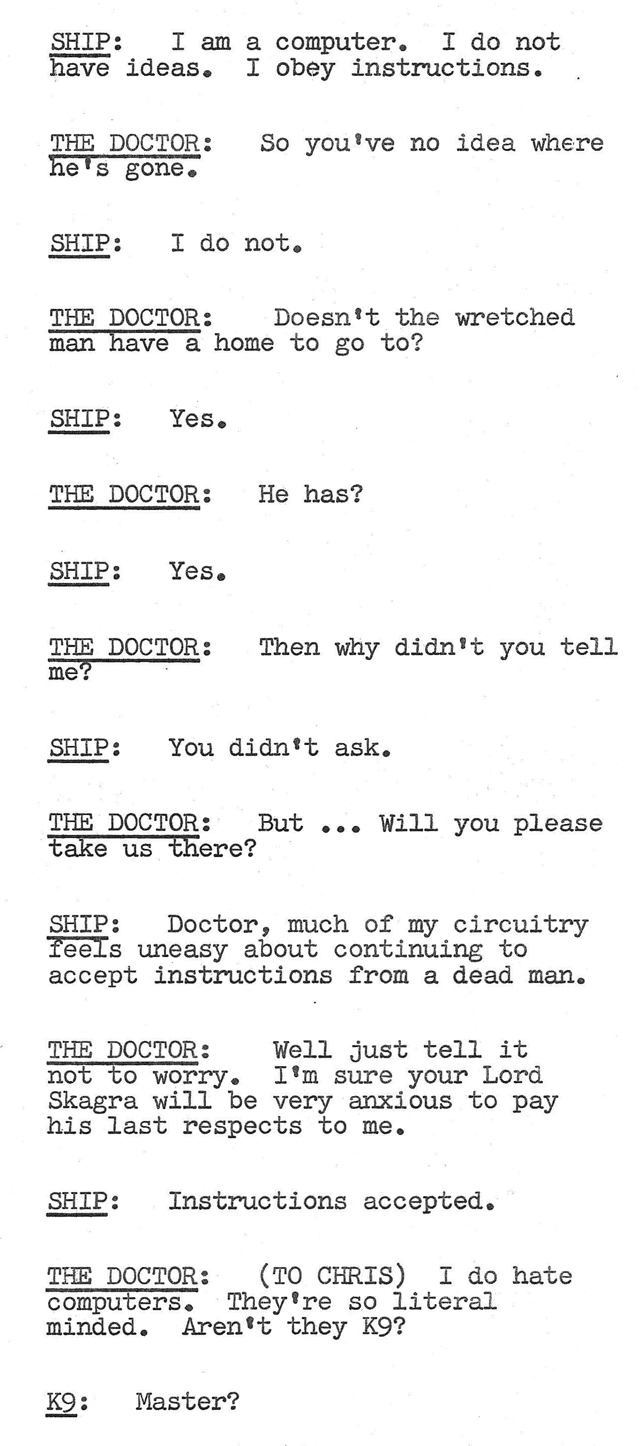
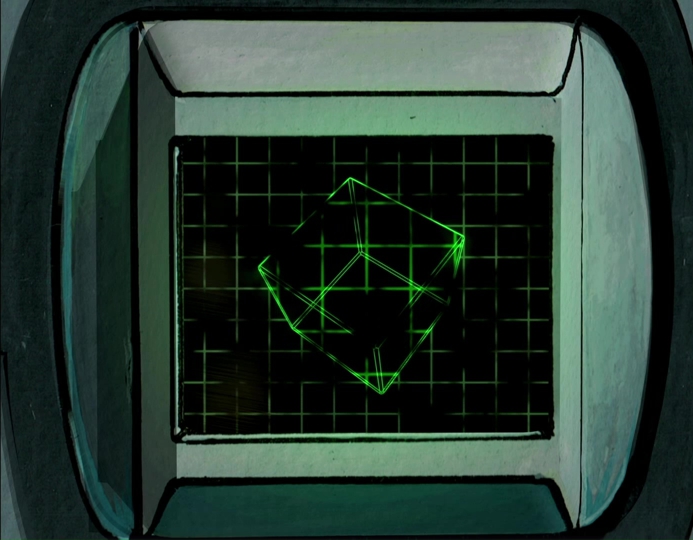
1:44:02 - The Doctor and Chris escape down the corridors
• CHARLES NORTON:
Most (but not quite all) of this scene was trimmed out for the BBC America broadcast. Incidentally, this is roughly where Part 3 of Shada would have ended, had it been completed as a four part serial for broadcast in 1981.
Most (but not quite all) of this scene was trimmed out for the BBC America broadcast. Incidentally, this is roughly where Part 3 of Shada would have ended, had it been completed as a four part serial for broadcast in 1981.
1:44:32 - Skagra continues not to rant about the escape
• CHARLES NORTON:
As originally scripted, there was a short cutaway scene here, of Skagra ranting that the Doctor should be: "caught and destroyed." Only a very brief scene, but we decided to skip it entirely and simply stay with the Doctor and Chris. The result is that what was originally scripted as two Chris and Doctor scenes are now merged into one. The join comes just before Chris' line of: "Doctor, that man must be mad, mustn't he?" There was also another short script trim a few seconds later. However, this was largely done to remove a line of dialogue that had originally been scripted to come from K9. We didn't have any existing David Brierley lines to cover it and so that meant another cut to the script.
As originally scripted, there was a short cutaway scene here, of Skagra ranting that the Doctor should be: "caught and destroyed." Only a very brief scene, but we decided to skip it entirely and simply stay with the Doctor and Chris. The result is that what was originally scripted as two Chris and Doctor scenes are now merged into one. The join comes just before Chris' line of: "Doctor, that man must be mad, mustn't he?" There was also another short script trim a few seconds later. However, this was largely done to remove a line of dialogue that had originally been scripted to come from K9. We didn't have any existing David Brierley lines to cover it and so that meant another cut to the script.
1:45:29 - A Krarg bangs on the door of Chronotis' TARDIS
• CHARLES NORTON:
Yes, it's another new bit of live-action. A scene that Pennant Roberts had planned to shoot back in 1979, but never got round to. We shot this at IMG studios on 13th September 2017, on the same day we did the Krarg's battle with K9. The professor's door was built by Mike Tucker, to match the original one used in the studio back in 1979. The Krarg is, as before, played by Barnaby Edwards and the whole thing was shot on the Ikegami tube camera. Both in terms of story order and production order, this was the last live-action scene to be shot with the Krarg. After this, the poor creature was allowed to go back into a graceful retirement in Kent.
• RICHARD BIGNELL:
On Saturday 16 December, I travelled back up to London to collect the half-beast, not to the Allsopp premises where I had left it, but to Mike Tucker’s workshop at Ealing Studios. The studios were a-bustle with the filming of the drama, A Very English Scandal with Hugh Grant playing MP, Jeremy Thorpe, but after finally finding Mike, we reloaded the costume back into my car. After spending some pleasant time chatting to Mike in his fascinating prop-filled office, I then had to suffer a nightmare of a journey back home through the heavy London Christmas traffic. The Krarg slept safely in the car overnight and was then returned to a grateful Roger the next day. Job done!
• CHARLES NORTON:
Incidentally, this last shot of the Krarg near the door was not included in the edit of the story broadcast on BBC America. However, there were no more cuts after this point. After this scene, the rest of Shada was broadcast uncut. BBC America also had a commercial break inserted at this point - with the cut material essentially making way for that.
Yes, it's another new bit of live-action. A scene that Pennant Roberts had planned to shoot back in 1979, but never got round to. We shot this at IMG studios on 13th September 2017, on the same day we did the Krarg's battle with K9. The professor's door was built by Mike Tucker, to match the original one used in the studio back in 1979. The Krarg is, as before, played by Barnaby Edwards and the whole thing was shot on the Ikegami tube camera. Both in terms of story order and production order, this was the last live-action scene to be shot with the Krarg. After this, the poor creature was allowed to go back into a graceful retirement in Kent.
• RICHARD BIGNELL:
On Saturday 16 December, I travelled back up to London to collect the half-beast, not to the Allsopp premises where I had left it, but to Mike Tucker’s workshop at Ealing Studios. The studios were a-bustle with the filming of the drama, A Very English Scandal with Hugh Grant playing MP, Jeremy Thorpe, but after finally finding Mike, we reloaded the costume back into my car. After spending some pleasant time chatting to Mike in his fascinating prop-filled office, I then had to suffer a nightmare of a journey back home through the heavy London Christmas traffic. The Krarg slept safely in the car overnight and was then returned to a grateful Roger the next day. Job done!
• CHARLES NORTON:
Incidentally, this last shot of the Krarg near the door was not included in the edit of the story broadcast on BBC America. However, there were no more cuts after this point. After this scene, the rest of Shada was broadcast uncut. BBC America also had a commercial break inserted at this point - with the cut material essentially making way for that.
Barnaby Edwards in the restored half-Krarg with K9 and Charles Norton (Image © John Kelly)
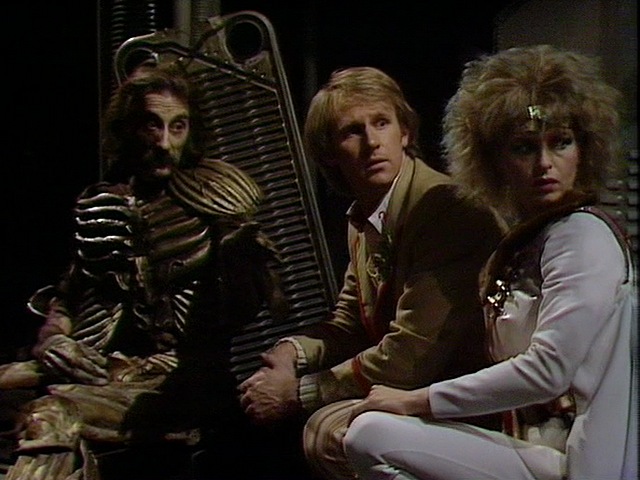
These same panels were later prominently reused as
set dressing in the 1983 story, Terminus.
set dressing in the 1983 story, Terminus.

















